F.A.Q
By when do I need to order if I want delivery this weekend?
Our cut of time for delivery for that weekend is the Thursday 7h00pm.
This ensures that have time to work out and plan our route for delivery that weekend.
You are always welcome to place an emergency order after that time, if we have another delivery close to you we will try our best to help you, if possible. We know life happens.
If you order late, also remember that Primal Pets for example makes all our orders fresh, so if you only order on the Friday, we will not be able to assist, as there will not be enough time on their side to make and freeze the product before we have to pick same up. There are exceptions and they may have small quantities of specific products available that were made in that week. So do still check with us in this case.
In these cases please always remember that with every late order that comes in, after our route is planned, there will be a ripple effect and this will affect all deliveries for that day to accommodate the extra orders, which were not planned for.
This ensures that have time to work out and plan our route for delivery that weekend.
You are always welcome to place an emergency order after that time, if we have another delivery close to you we will try our best to help you, if possible. We know life happens.
If you order late, also remember that Primal Pets for example makes all our orders fresh, so if you only order on the Friday, we will not be able to assist, as there will not be enough time on their side to make and freeze the product before we have to pick same up. There are exceptions and they may have small quantities of specific products available that were made in that week. So do still check with us in this case.
In these cases please always remember that with every late order that comes in, after our route is planned, there will be a ripple effect and this will affect all deliveries for that day to accommodate the extra orders, which were not planned for.
By when do I need to order if I want to collect my order?
You can order at any time... night or day.
Please just note that we do not keep huge amounts of stock on our premises anymore. We try to keep all products as fresh as possible for the best quality for your pet.
We normally pick up stock on Saturdays and therefore pickups can be arranged for late Saturday's, Sunday's or during the following week then, unless you order from stock that is on the premises. But don't worry we will let you know if this is the case.
We will confirm with you once your order is packed and ready for pickup.
Please always give us a headsup before you arrive. This is only so that you don't have to wait while we pack your order. We can not be held responsible if you have to wait for your order to be packed if we didn't even know you were coming.
Most of the time there is always someone at home as we do not like to leave our own doggo babies on their own. But it may happen that the whole family needs to go somewhere, so always make sure to check with us when you can collect.
Please just note that we do not keep huge amounts of stock on our premises anymore. We try to keep all products as fresh as possible for the best quality for your pet.
We normally pick up stock on Saturdays and therefore pickups can be arranged for late Saturday's, Sunday's or during the following week then, unless you order from stock that is on the premises. But don't worry we will let you know if this is the case.
We will confirm with you once your order is packed and ready for pickup.
Please always give us a headsup before you arrive. This is only so that you don't have to wait while we pack your order. We can not be held responsible if you have to wait for your order to be packed if we didn't even know you were coming.
Most of the time there is always someone at home as we do not like to leave our own doggo babies on their own. But it may happen that the whole family needs to go somewhere, so always make sure to check with us when you can collect.
What do I do if I am technologically impaired and cannot place my own order?
No worries, we've got you.
Just send a whatsapp of what you would like and we will place the order on your behalf.
Just send a whatsapp of what you would like and we will place the order on your behalf.
What happens if I don't see what I want?
No stress. We've got you
First thing you can do is place your order as early as possible in the week. We load new stock normally on a Monday or Tuesday. So you snooze you may loose... but
Because our clients' happiness and off course your pet's happiness is very important to us, you are more than welcome to send us a whatsapp to request the products that are out of stock. We will then try to move mountains to get it for you.
But off course if you only realize this on Thursday night or even Friday, our hands are tied, we will off course still try, but just as with us, our suppliers also have to do deliveries, make the product etc. Our local suppliers are extremely nice and most of the time willing to help. But please remember that the earlier you order or request outstanding products the higher your chances are that we can help. And we hate disappointing our clients.
First thing you can do is place your order as early as possible in the week. We load new stock normally on a Monday or Tuesday. So you snooze you may loose... but
Because our clients' happiness and off course your pet's happiness is very important to us, you are more than welcome to send us a whatsapp to request the products that are out of stock. We will then try to move mountains to get it for you.
But off course if you only realize this on Thursday night or even Friday, our hands are tied, we will off course still try, but just as with us, our suppliers also have to do deliveries, make the product etc. Our local suppliers are extremely nice and most of the time willing to help. But please remember that the earlier you order or request outstanding products the higher your chances are that we can help. And we hate disappointing our clients.
Can I order weekly or monthly?
You can order weekly or monthly.
We do suggest that you order as much as your freezer space will allow to save on costs. Otherwise you have to pay delivery charges every week.
We do suggest that you order as much as your freezer space will allow to save on costs. Otherwise you have to pay delivery charges every week.
I'm scared I forget to order, can you help?
We've got you.
We send out 2 weekly reminders to order. The first one as soon as we have loaded new stock with any news and updates we have to tell you about and a final reminder on Thursday morning to order before 7h00pm that day.
Please save our number on your phone to ensure that you receive the messages. You will not receive our broadcast messages if we are not saved as a contact.
We will not bombard you with unnecessary messages, we also hate it when places do that.
We send out 2 weekly reminders to order. The first one as soon as we have loaded new stock with any news and updates we have to tell you about and a final reminder on Thursday morning to order before 7h00pm that day.
Please save our number on your phone to ensure that you receive the messages. You will not receive our broadcast messages if we are not saved as a contact.
We will not bombard you with unnecessary messages, we also hate it when places do that.
I'm to busy to order, can you help?
Yip, we can help.
We can create reminders on our side to either remind you to order, or order on your behalf every week, 2 weeks, month or whatever the case may be.
This off course will only work if your order stays the same, otherwise you can just let us know what you want, and we will do the rest.
We can create reminders on our side to either remind you to order, or order on your behalf every week, 2 weeks, month or whatever the case may be.
This off course will only work if your order stays the same, otherwise you can just let us know what you want, and we will do the rest.
I really need to order, but can't pay now, is that ok?
Yes.
We do accept arrangements if you really, really need to order now but can only pay later. But only with prior arrangement.
This is the only time we will hound you with messages if you did not make an arrangement to pay at a later stage and your payment is past due.
And Remember, we know where you live.... and your dog's like us (well most of them...)
We do accept arrangements if you really, really need to order now but can only pay later. But only with prior arrangement.
This is the only time we will hound you with messages if you did not make an arrangement to pay at a later stage and your payment is past due.
And Remember, we know where you live.... and your dog's like us (well most of them...)
Im new, where do I begin and what do I order?
Well done on getting this far, the rest is easy.
You can whatsapp us anytime, we are basically always available to help, guide and give advise. Remember we are not Vet's but we can always give the best advise from our personal knowledge and experience.
We will guide you through the process.
You can whatsapp us anytime, we are basically always available to help, guide and give advise. Remember we are not Vet's but we can always give the best advise from our personal knowledge and experience.
We will guide you through the process.
What makes biologically appropriate raw food different?
Biologically appropriate raw food is designed to mimic a dog's natural diet, providing essential nutrients and minimizing unnecessary additives. It may lead to improved digestion, healthier coats, and increased energy levels for your dog.
To which areas do you delivery?
We deliver to the whole of Gauteng over weekends.
There are plans to branch out to other areas in the near future.
There are plans to branch out to other areas in the near future.
When is delivery?
We deliver over weekends. A msg is sent out on Fridays to confirm when and approximately what time your delivery will be.
There are plans to bring in weekday deliveries, but at this stage Rudolf is still working during the week.
There are some weeks were a delivery may be on a Friday, but will be arranged with the specific client in advance
Do you deliver during the week?
At this stage, no we do not.
There are plans to include week days in the delivery schedule.
There are plans to include week days in the delivery schedule.
Something came up and I'm not going to be home when you deliver, now what?
No worries. We always try to accommodate our client's as far as possible. Just make sure you let us know when your plans or address change.
We can always meet you somewhere, drop the food at a friend or neighbor, or even with the security guard at the gate. But.... we use boxes to transport your orders in so if we do not know that you are not home, we cannot leave your order with a security guard as the product will defrost, and its extremely important that the cold chain be kept in tact as a product that is left in the sun can make your pet severely sick.
So if something comes up, don't worry just let us know and we will pack your order safely and snuggly in a polybox container that will keep it frozen until you get home. (Pls note it should never ever be left in direct sun, no matter how your order is packed) and we cannot accept liability once we have delivered the product to you and it was left outside for whatever reason.
NB: If you did not arrange anything with us, and we cannot get hold of you on delivery, we will not just leave your food with someone or somewhere without your consent or prior arrangement.
We can always meet you somewhere, drop the food at a friend or neighbor, or even with the security guard at the gate. But.... we use boxes to transport your orders in so if we do not know that you are not home, we cannot leave your order with a security guard as the product will defrost, and its extremely important that the cold chain be kept in tact as a product that is left in the sun can make your pet severely sick.
So if something comes up, don't worry just let us know and we will pack your order safely and snuggly in a polybox container that will keep it frozen until you get home. (Pls note it should never ever be left in direct sun, no matter how your order is packed) and we cannot accept liability once we have delivered the product to you and it was left outside for whatever reason.
NB: If you did not arrange anything with us, and we cannot get hold of you on delivery, we will not just leave your food with someone or somewhere without your consent or prior arrangement.
I forgot you are delivering... now what?
We understand life happens.
This being said, due to the nature of the product, and our as well as our supplier's reputation, we cannot and will not just leave your order, without your prior consent or arrangement.
We will attempt anything and everything to contact you on delivery, but if it happens that you miss us, please understand that we do between 20 - 30 deliveries on a Saturday or Sunday, and we cannot wait for, at most, more than 10 minutes for you. Just like you, there are other clients also waiting for their deliveries on a specific time and have plans. We cannot disrupt 20 - 30 other clients to wait for one client.
If possible we will then try to deliver your food as soon as possible, maybe on the way back if we go past you again, maybe on Sunday otherwise if all else fails, then the next weekend.
You are also welcome to pick up your order from us at any time. We can then however not credit your delivery fee as we have already attempted delivery to you. We may charge you for another delivery the next weekend if we do not have another client close by and we have to change our route to delivery your order.
We do hope you understand.
This being said, due to the nature of the product, and our as well as our supplier's reputation, we cannot and will not just leave your order, without your prior consent or arrangement.
We will attempt anything and everything to contact you on delivery, but if it happens that you miss us, please understand that we do between 20 - 30 deliveries on a Saturday or Sunday, and we cannot wait for, at most, more than 10 minutes for you. Just like you, there are other clients also waiting for their deliveries on a specific time and have plans. We cannot disrupt 20 - 30 other clients to wait for one client.
If possible we will then try to deliver your food as soon as possible, maybe on the way back if we go past you again, maybe on Sunday otherwise if all else fails, then the next weekend.
You are also welcome to pick up your order from us at any time. We can then however not credit your delivery fee as we have already attempted delivery to you. We may charge you for another delivery the next weekend if we do not have another client close by and we have to change our route to delivery your order.
We do hope you understand.
Why do I have to pay a delivery fee?
Some of our our older clients may remember that we never used to charge for delivery, but unfortunately, it has become a rule from some of our suppliers to keep the peace and uniformity between the different stockists, that we have to charge a minimum of R60 delivery on each order.
You can however, get your neighbor, friend or anybody that is willing, on board to order with you to share the delivery cost. You just have to order on the same weekend and note who you are ordering with on your orders, and we will share the delivery cost between the 2 orders.
If you dont have anyone that you can convince to join the raw feeding revolution ask us, we may have another client close to you, we can put you guys in contact with each other and let the sharing begin.
You can however, get your neighbor, friend or anybody that is willing, on board to order with you to share the delivery cost. You just have to order on the same weekend and note who you are ordering with on your orders, and we will share the delivery cost between the 2 orders.
If you dont have anyone that you can convince to join the raw feeding revolution ask us, we may have another client close to you, we can put you guys in contact with each other and let the sharing begin.
By when do I need to pay for my order?
We understand that for new clients, you need to get to know us first, so you are welcome to pay for your order once we deliver same to you or when you come and pick it up.
Thereafter, payment confirms delivery or pickup. Your payment does not have to show immediately, but we do require at least a proof of payment to release your order
Thereafter, payment confirms delivery or pickup. Your payment does not have to show immediately, but we do require at least a proof of payment to release your order
Can I pay cash?
Yes you can, but however we do prefer eft, as cash payments pose a risk to our drivers safety on the road as well as when the cash has to be deposited, it's also costly to deposit into our bank account.
You may also make a direct cash deposit into our account if you are not able to make an eft payment or pay cash on delivery.
You may also make a direct cash deposit into our account if you are not able to make an eft payment or pay cash on delivery.
Can I make an eft payment?
Yes, please do, we prefer eft payments as its the easiest, quickest and safest option of payment at this stage
Do you have card facilities?
Unfortunately we do not at this stage.
These little machines have a huge cost attached per transaction and monthly, and as as mall family business we are trying to keep costs to ourselves and to your as low as possible
These little machines have a huge cost attached per transaction and monthly, and as as mall family business we are trying to keep costs to ourselves and to your as low as possible
Do you have merchant payment services?
At this stage, we unfortunately do not.
As a family owned owned and run business we are trying to keep the costs you us and you our client as low as possible, and these types of payments carry huge costs attached to them.
We may implement same at a later stage, with an extra cost to cover the above added to your order, we are looking into this.
As a family owned owned and run business we are trying to keep the costs you us and you our client as low as possible, and these types of payments carry huge costs attached to them.
We may implement same at a later stage, with an extra cost to cover the above added to your order, we are looking into this.
How much do I feed my puppy?
This is a guideline only and all meals must be adjusted to suit the individual needs of your pet, as you know you baby best.
Puppies 4 - 8 weeks
6% - 10% of body weight divided into 3 to 4 meals per day
Puppies 8 weeks to 6 months
5% to 8% of body weight divided into 2 to 3 meals per day
Up to 4 months, puppies should be fed either poultry neck, head or wing complete meals because of the higher bone content. Whole pieces can also be added, always under supervision.
6 to 8 months old
4% to 6% of current weight divided in 3 meals daily
8 to 12 months old
3% - 4% of current weight divided in 3 meals
After 8 months percentage depends on breed and activity level of dog. The idea is that the puppy gets a very bone rich diet in the first 6 months of their live. We recommend adding whole wings and necks as long as possible as this will help the puppy grow strong.
12 months and older
2% to 3% of ideal weight divided in 2 meals (revert to adult feeding guide)
How much do I feed my adult dog?
This is a guideline only and all meals must be adjusted to suit the individual needs of your pet, as you know you baby best.
Use the guideline to determine how much you would need to feed by using this formula
WEIGHT OF ANIMAL x % TO FEED = FOOD TO FEED ON A DAILY BASIS
Healthy, non-active dogs (couch potatoes)
2% - 3% of weight divided in 1 to 2 meals per day
Healthy, active or working dogs
3% - 6% of weight divided in 1 to 3 meals per day
Pregnant or "in whelp"
2% - 3% during the first 2 thirds of the pregnancy and during the last third of the pregnancy increase to 3% - 6% divided into 2 or 3 meals per day.
Lactating females
Depending on the size of the litter feed 3% - 6% of body weight in 2 to 3 meals per day, adapt for the size of the litter if the litter is very big
Maintaining a balanced raw diet for cats and dogs by As Nature Intended
Cats
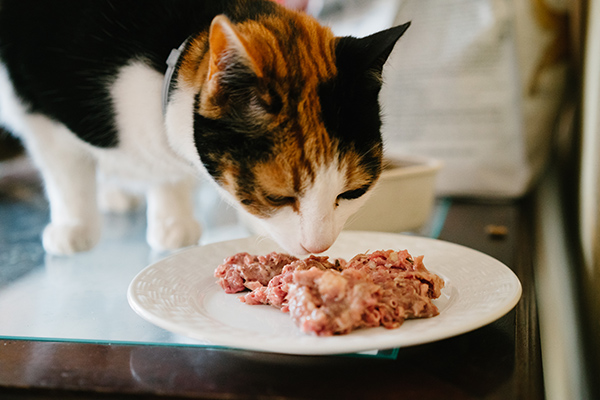
For cats, we suggest you start with one protein type of “Cat of the Day” complete dinners (Chicken, Turkey, or Ostrich), as too many changes can create problems. Add the next flavour when they are ready. The meals are completely balanced. This does not mean that you can’t enhance the benefits of raw feeding by giving occasional extras – especially whole foods. Have a look at our Menu page for some suggestions! At a glance – chicken necks are great to get them chewing, and to keep those teeth clean. An occasional fresh raw fish will give them an Omega-3 boost – we stock yummy pilchards for this purpose. If you do want to give your cats extra egg it is vital to remember yolk only – they cannot tolerate egg white.
Dogs
Dogs naturally eat a greater variety of foods. Your basic meal plan for a normal healthy dog should include the full range of our “Give a Dog a Bone” complete dinners – Chicken, Turkey, Ostrich, Venison, and Beef. This will ensure balanced nutrition. We suggest that you feed one meat type for 2-3 meals at a time, for optimal digestion.
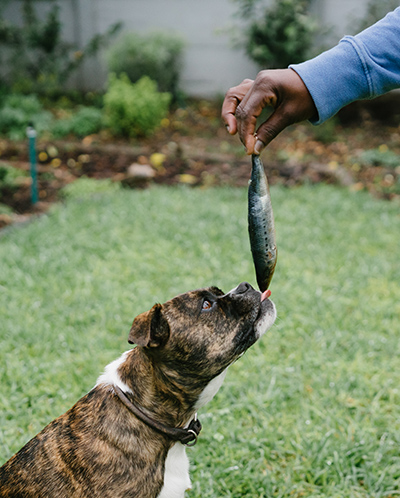
It is also important to add whole foods to their diets, to exercise their fine motor co-ordination, and to keep their teeth strong and healthy. Your dogs will love our range, including chicken wings, necks and things, beef bones, venison ribs, duck carcasses, and turkey drumsticks and tails, to name a few. They should get whole foods at least twice a week. Oily fish is a very important source of Omega-3 for dogs, and they love it! Give your dog a whole pilchard – none of it will go to waste. Some owners are scared of the bones in the chicken and fish, but there is no need to fear. Cooked bones are brittle and extremely dangerous, which is why we emphasize that you should never cook our food. But raw bones are soft and flexible, and are a vital part of your pet’s diet.Small pieces of fruit can be a treat for dogs, but never grapes or raisins, as these are toxic to them. Don’t overdo the whole fruit – they don’t digest it very easily, and it can come out whole in their stools.If you want to have some fun, give your dog an occasional whole raw egg. They will relish it, shell and all. The first time we gave Satchmo and Kaesha an egg each, Satchmo spent ages rolling it around, trying to figure out how to break the shell. Kaesha, on the other hand, took it straight to the concrete outside, dropped it so it cracked, and licked out every last drop before crunching up the shell. Delicious!
All Pets
If your dogs and cats are not getting regular oily fish meals then it is necessary to supplement their food with salmon oil for Omega-3. Although there is Omega-3 in our food, the freezing process affects the levels, so we sell Salmon Oil capsules separately as a supplement. Do not use vegetable based Omega-3 (hemp, soy) as they do not offer the same benefits.
If your dog or cat suffers from any illness, please let us know. We can help to plan an optimum diet for them, and can also suggest the addition of specific herbs to their diet. We already have a variety of Special Recipes for certain medical complaints, and are always happy to research new ones for your cat or dog. We also stock a great range of herbal supplements, particularly for dogs and cats with skin problems, and for dogs with joint problems.

For cats, we suggest you start with one protein type of “Cat of the Day” complete dinners (Chicken, Turkey, or Ostrich), as too many changes can create problems. Add the next flavour when they are ready. The meals are completely balanced. This does not mean that you can’t enhance the benefits of raw feeding by giving occasional extras – especially whole foods. Have a look at our Menu page for some suggestions! At a glance – chicken necks are great to get them chewing, and to keep those teeth clean. An occasional fresh raw fish will give them an Omega-3 boost – we stock yummy pilchards for this purpose. If you do want to give your cats extra egg it is vital to remember yolk only – they cannot tolerate egg white.
Dogs
Dogs naturally eat a greater variety of foods. Your basic meal plan for a normal healthy dog should include the full range of our “Give a Dog a Bone” complete dinners – Chicken, Turkey, Ostrich, Venison, and Beef. This will ensure balanced nutrition. We suggest that you feed one meat type for 2-3 meals at a time, for optimal digestion.

It is also important to add whole foods to their diets, to exercise their fine motor co-ordination, and to keep their teeth strong and healthy. Your dogs will love our range, including chicken wings, necks and things, beef bones, venison ribs, duck carcasses, and turkey drumsticks and tails, to name a few. They should get whole foods at least twice a week. Oily fish is a very important source of Omega-3 for dogs, and they love it! Give your dog a whole pilchard – none of it will go to waste. Some owners are scared of the bones in the chicken and fish, but there is no need to fear. Cooked bones are brittle and extremely dangerous, which is why we emphasize that you should never cook our food. But raw bones are soft and flexible, and are a vital part of your pet’s diet.Small pieces of fruit can be a treat for dogs, but never grapes or raisins, as these are toxic to them. Don’t overdo the whole fruit – they don’t digest it very easily, and it can come out whole in their stools.If you want to have some fun, give your dog an occasional whole raw egg. They will relish it, shell and all. The first time we gave Satchmo and Kaesha an egg each, Satchmo spent ages rolling it around, trying to figure out how to break the shell. Kaesha, on the other hand, took it straight to the concrete outside, dropped it so it cracked, and licked out every last drop before crunching up the shell. Delicious!
All Pets
If your dogs and cats are not getting regular oily fish meals then it is necessary to supplement their food with salmon oil for Omega-3. Although there is Omega-3 in our food, the freezing process affects the levels, so we sell Salmon Oil capsules separately as a supplement. Do not use vegetable based Omega-3 (hemp, soy) as they do not offer the same benefits.
If your dog or cat suffers from any illness, please let us know. We can help to plan an optimum diet for them, and can also suggest the addition of specific herbs to their diet. We already have a variety of Special Recipes for certain medical complaints, and are always happy to research new ones for your cat or dog. We also stock a great range of herbal supplements, particularly for dogs and cats with skin problems, and for dogs with joint problems.
How to feed your dog or cat. By Chefs4Pets
Safe Handling and Thawing Guide
- Common sense should prevail when handling raw meat. You do this all the time preparing a family meal, so it should not be something new to you.
- Keep all meals frozen, until ready to thaw and feed
- Thaw food in the refrigerator the day before feeding. Use an airtight container to prevent odour and contamination of other foods in the fridge.
- A quick thaw should only be done in cold water
- Never cook or microwave the raw meal
- Always clean up and disinfect the area used for the raw food preparation after completing the feeding
My dog or cat does not want to eat the food, now what?
You can try to add some plain, unscented, unflavored white Greek Yogurt or some pure honey (just a drop or two) to the food.
You can also try to add a favorite treat in the food, so that they have to eat the food to get to the treat.
As last resort you can crush some of the pellets over the food to entice your dog or cat to eat the raw food.
If they still don't want to, don't give up. Just remove the food, place it in the fridge and try again a later.
Do not give in and give them what they are used to, you know what's best for them, just keep trying and persisting, it's the best for them.
You can also try to add a favorite treat in the food, so that they have to eat the food to get to the treat.
As last resort you can crush some of the pellets over the food to entice your dog or cat to eat the raw food.
If they still don't want to, don't give up. Just remove the food, place it in the fridge and try again a later.
Do not give in and give them what they are used to, you know what's best for them, just keep trying and persisting, it's the best for them.
How to transition as suggested by As Nature Intended
For most pets, faster is better!
Most animals do best with a quick change to a raw food diet – quite simply take away the old cat food or dog food and begin feeding the new Give a Dog a Bone or Cat of the Day Dinners. The food smells and tastes delicious, and most pets instinctively recognize and enjoy it. The quick switch is especially important for dogs and cats suffering from allergies or skin problems. Some pets are fussier, but we have tips and tricks for them, don’t worry!
Experienced raw pet food feeders suggest that you allow your animals a 24-hour fast, or a mini-fast, before their first raw meal. This method helps with the detoxification process. A mini-fast means that you skip their normal food for one dinner, perhaps replacing it with a nice meaty beef bone for dogs or a chicken neck for cats. Then you give them their first complete raw meal for breakfast the next day. Please note that although dogs can tolerate long fasts, cats should never be fasted for more than 24 hours.
Most owners struggle with the fasting idea, so we only suggest it for the very brave! If you don’t want to do the fast, just make sure that you are relaxed about the switch as your pets will pick up on any tension. Simply feed them their new delicious food without any fuss.
Digestive Disturbances by As Nature Intended
Digestive Disturbances
It is best to feed your dogs one kind of meat (Give a Dog a Bone Chicken, Turkey, Beef, or Venison Dinners) for 2-3 days before introducing the next “flavor”. This helps their digestive systems to adapt.
For cats, you might stick to either Cat of the Day Chicken or Turkey for quite a while, as changes can cause fussiness.
Either way, if you are switching your animals from kibble (pellets) or cooked food, don’t be alarmed if their stools are a bit mucousy or runny for the first two days. Their systems are just ridding themselves of toxins. If they still have runny stools after this, please check that their de-worming is up to date.
It is best to feed your dogs one kind of meat (Give a Dog a Bone Chicken, Turkey, Beef, or Venison Dinners) for 2-3 days before introducing the next “flavor”. This helps their digestive systems to adapt.
For cats, you might stick to either Cat of the Day Chicken or Turkey for quite a while, as changes can cause fussiness.
Either way, if you are switching your animals from kibble (pellets) or cooked food, don’t be alarmed if their stools are a bit mucousy or runny for the first two days. Their systems are just ridding themselves of toxins. If they still have runny stools after this, please check that their de-worming is up to date.
Pernickety Pooches by As Nature Intended
For old dogs, young puppies, or sickly dogs, and for some canine fussy eaters, a slow switch to Give a Dog a Bone raw food may be better.
With this method, you would change your dog’s diet over four days as follows:
You know your own dog best, so we trust you to choose the method that is best for him or her. Just be sure that you are not reacting to any of your own fears about the new diet, and feel free to call us if you are feeling unsure in any way.
With this method, you would change your dog’s diet over four days as follows:
- Day 1: 75% of their old food mixed well with 25% “Give a Dog a Bone”. (It is important to mix this well, so that it all becomes one “glop” of food – if the old food is pellets, allow time for the pellets to absorb the moisture before you serve)
- Day 2: A 50/50 mix of both foods
- Day 3: 25% of the old dog food, 75% “Give a Dog a Bone”
- Day 4: 100% raw food
You know your own dog best, so we trust you to choose the method that is best for him or her. Just be sure that you are not reacting to any of your own fears about the new diet, and feel free to call us if you are feeling unsure in any way.
Fussy Felines by As Nature Intended
Cats are notoriously fussy eaters! They instinctively resist changes to their diets. Some cats will make a quick switch to raw food with no problems. For most older cats, however, more time and patience is needed. In the words of our very own Sharna, whose 3 year old cat Bella was a prime example of feline fussiness.
In the beginning, it was a struggle for me to make the switch – it took me 3 months. I tried everything, from bribery to begging her to eat the food, not knowing that she was picking up on my anxiety. But I was persistent, and now she’s a different cat, bounces around, clean breath, amazing coat, no smelly stools and to top it all off, she gets excited for supper time. Hearing your kitty purr while eating her food just makes you feel like you did the right thing (cause cats are fussy!)
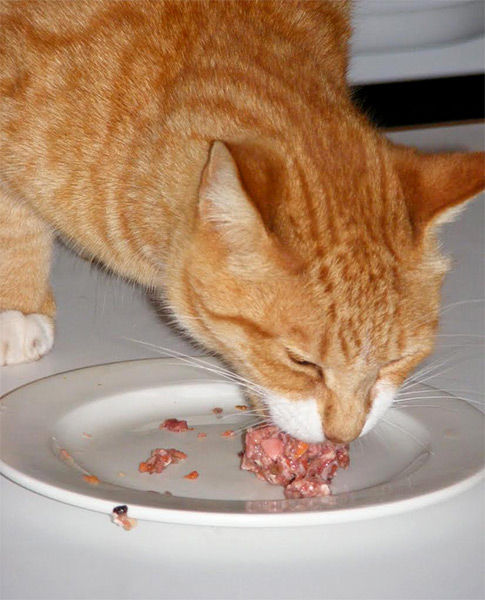
So, how to convince your cat to make the switch? If you have been feeding pellets/kibble, your first step is to get it right out of the house (or at the very least, put it in the fridge). Dried cat food is coated with addictive flavourants that give off very strong scents. With their incredible senses of smell, cats will know that the dried food is still around, and will hold out for it because it is familiar.If you have been free-feeding dry cat food (in other words, leaving the bowl out all day), your cat will need to get used to meals on a schedule. Remember that cats are naturally nocturnal eaters, so your kitty will eat more at night. Feed the Cat of the Day raw food twice a day at regular times (with the bigger portion in the evenings). Do not leave it out for more than twenty minutes. Don’t give in to fear if your cat does not respond well immediately – you are trying to change a life-time habit, and it will take your pet a minimum of a week to ten days to trust the adjustment (it could take longer). Trust us – it is worth pushing through!
If you need to entice your cat when introducing the raw food, you can use some flavor “bribes”! A sprinkling of Parmesan cheese on the food often works well. Or a little bit of fish oil. If you are really desperate, you can crush some of the dry food and sprinkle this over the raw food. If your cat will still not take to the raw meal, try switching it to a cooked or canned food first so that it gets used to the texture of moist food. A wonderful website that is filled with ideas on this subject is feline-nutrition.org.
Don’t let all this talk of difficulties scare you off. Keep in mind that many cats take to Cat of the Day raw food quickly and with delight. Even the ones who are more suspicious of the change end up loving their new food – remember what Sharna said about Bella’s purr! Raw is their natural way of eating – it’s humans who have trained them out of it. Give your stubborn cat some time, and its instincts will break through.
In the beginning, it was a struggle for me to make the switch – it took me 3 months. I tried everything, from bribery to begging her to eat the food, not knowing that she was picking up on my anxiety. But I was persistent, and now she’s a different cat, bounces around, clean breath, amazing coat, no smelly stools and to top it all off, she gets excited for supper time. Hearing your kitty purr while eating her food just makes you feel like you did the right thing (cause cats are fussy!)

So, how to convince your cat to make the switch? If you have been feeding pellets/kibble, your first step is to get it right out of the house (or at the very least, put it in the fridge). Dried cat food is coated with addictive flavourants that give off very strong scents. With their incredible senses of smell, cats will know that the dried food is still around, and will hold out for it because it is familiar.If you have been free-feeding dry cat food (in other words, leaving the bowl out all day), your cat will need to get used to meals on a schedule. Remember that cats are naturally nocturnal eaters, so your kitty will eat more at night. Feed the Cat of the Day raw food twice a day at regular times (with the bigger portion in the evenings). Do not leave it out for more than twenty minutes. Don’t give in to fear if your cat does not respond well immediately – you are trying to change a life-time habit, and it will take your pet a minimum of a week to ten days to trust the adjustment (it could take longer). Trust us – it is worth pushing through!
If you need to entice your cat when introducing the raw food, you can use some flavor “bribes”! A sprinkling of Parmesan cheese on the food often works well. Or a little bit of fish oil. If you are really desperate, you can crush some of the dry food and sprinkle this over the raw food. If your cat will still not take to the raw meal, try switching it to a cooked or canned food first so that it gets used to the texture of moist food. A wonderful website that is filled with ideas on this subject is feline-nutrition.org.
Don’t let all this talk of difficulties scare you off. Keep in mind that many cats take to Cat of the Day raw food quickly and with delight. Even the ones who are more suspicious of the change end up loving their new food – remember what Sharna said about Bella’s purr! Raw is their natural way of eating – it’s humans who have trained them out of it. Give your stubborn cat some time, and its instincts will break through.
Dogs and Cats: Other important tips for the switch by As Nature Intended
For both dogs and cats, it is important to limit treats during the period of introduction to the new food. If you really can’t resist, let your treats be bits of raw natural food: whole food like some chicken portion trimmings, a bone to chew on, a chicken neck, the occasional egg yolk, some dried liver, or a small piece of apple or banana (fruit treats are only for dogs).
Don’t forget to always provide plenty of access to clean water, though you’ll notice your pets will drink less on their new moist food.
Remember that plastic feeding bowls are dangerous, and must be replaced with stainless steel or a good quality glazed ceramic bowl.
One more note about stools. Once your pet has made the switch, their stools will become firm and white. Don’t be alarmed by this, or by seeing them strain slightly to defecate. Both of these are good signs.
Lastly, remember that every cat and dog is unique. You know your own cats and dogs best. Read as much as you need to, to allay any fears or anxieties you may have. Talk to us more if you have any questions. Then, trust your instincts, and theirs.
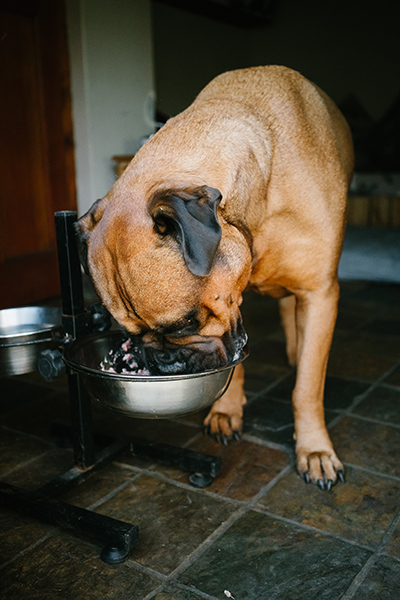
Don’t forget to always provide plenty of access to clean water, though you’ll notice your pets will drink less on their new moist food.
Remember that plastic feeding bowls are dangerous, and must be replaced with stainless steel or a good quality glazed ceramic bowl.
One more note about stools. Once your pet has made the switch, their stools will become firm and white. Don’t be alarmed by this, or by seeing them strain slightly to defecate. Both of these are good signs.
Lastly, remember that every cat and dog is unique. You know your own cats and dogs best. Read as much as you need to, to allay any fears or anxieties you may have. Talk to us more if you have any questions. Then, trust your instincts, and theirs.

How to transition. By Doggobone
Making the Transformation
We recommend a 6-day feeding schedule with a day of fasting on the 7th day.
Fasting is an age-old practice and has been known to aid digestion and help cleanse the body of toxins. It is not un-common for animals in the wild to fast. For those who are concerned about fasting their pet we suggest feeding plain yougurt as the alternative to food. It is not advisable to fast puppies under the age of 6 months and ensure your pet has clean fresh water available at all times.
Recommended Method
Rapid Switch: If your pet has a strong immune system and is generally quite healthy, an immediate conversion can be done. On the first day fast your pet for 24 hours to allow the body to cleanse itself of toxins and to make your pet eager for their next day’s meal.
Kindly Be aware that the normal detoxification process may cause temporary symptoms of vomiting or diarrhea and will differ from animal to animal.
*This may also be the result of eating too fast, gulping, or possible temperature variations.
*There is no need to be alarmed if these symptoms occur, as your pet’s digestive system gets used to the change.
Slow Switch: This method is strongly recommended for pets with compromised immune systems or sensitivity to dramatic changes in diets. The raw diet should be introduced slowly to prevent major detoxification symptoms.
We recommend a 6-day feeding schedule with a day of fasting on the 7th day.
Fasting is an age-old practice and has been known to aid digestion and help cleanse the body of toxins. It is not un-common for animals in the wild to fast. For those who are concerned about fasting their pet we suggest feeding plain yougurt as the alternative to food. It is not advisable to fast puppies under the age of 6 months and ensure your pet has clean fresh water available at all times.
Recommended Method
Rapid Switch: If your pet has a strong immune system and is generally quite healthy, an immediate conversion can be done. On the first day fast your pet for 24 hours to allow the body to cleanse itself of toxins and to make your pet eager for their next day’s meal.
Kindly Be aware that the normal detoxification process may cause temporary symptoms of vomiting or diarrhea and will differ from animal to animal.
*This may also be the result of eating too fast, gulping, or possible temperature variations.
*There is no need to be alarmed if these symptoms occur, as your pet’s digestive system gets used to the change.
Slow Switch: This method is strongly recommended for pets with compromised immune systems or sensitivity to dramatic changes in diets. The raw diet should be introduced slowly to prevent major detoxification symptoms.
- Day 1: On the first day fasting is recommended to allow the body to cleanse itself of toxins and get your pet eager for raw.
- Day 2: Start out with 10% being the raw diet and 90% of the old diet.
- Day 3-10: Increase the raw diet each day by 10% and decrease the old diet by 10% for the next 9 days.
- Day 11: You should be feeding only the RAW DIET.
Will my dog become more aggressive once he / she has tasted blood? By As Nature Intended
Absolutely not.
All animals may be a little possessive over their food (a survival tactic in the wild), so we would recommend giving your pet a little space while they are actually eating, but that is true regardless of what you are feeding them or how sweet they may be.
Trust your common sense – don’t let your two-year-old tug on ANY dog’s ears while they are enjoying their supper, for example – but there is absolutely no correlation between raw feeding and behavioral problems in general or aggression in particular.
All animals may be a little possessive over their food (a survival tactic in the wild), so we would recommend giving your pet a little space while they are actually eating, but that is true regardless of what you are feeding them or how sweet they may be.
Trust your common sense – don’t let your two-year-old tug on ANY dog’s ears while they are enjoying their supper, for example – but there is absolutely no correlation between raw feeding and behavioral problems in general or aggression in particular.
Will my pet get sick from eating raw meat? By As Nature Intended
This is something many people are nervous about, so it’s a good question. Many opponents of raw feeding (mostly kibble / pellet companies) have raised a lot of fear about pathogens in raw meat.
Firstly, to put your mind at ease, our food is registered, which means that we are subject to strict control regarding levels of bacteria / pathogens / salmonella in the food. The food gets tested at regular intervals, and so far has always come back with far better test results than even strictly necessary. These results are sent to the Department of Agriculture, who have even tighter rules about pet food than our South African laws on human food!
So our food is very safe for your pet, and for you.
Regardless, let’s talk a little about bacteria in raw meat. Some of the confusion and fear comes in because one of the reasons humans cook much of what we eat is to kill bacteria. Dogs’ and cats’ stomachs are highly acidic, far more so than humans, which helps them process bacteria like salmonella (and others) without getting sick. The natural digestive enzymes and bile in their systems aid safe digestion and rejection of bad bacteria. Live enzymes in raw food help to boost your pet’s immune system and make it even better at this (sadly kibble is processed at way too high a temperature for these enzymes to survive, which can contribute to a weakened immune system in pets who only eat pellets… but this can be reversed when they return to a natural diet, so never fear!).
Firstly, to put your mind at ease, our food is registered, which means that we are subject to strict control regarding levels of bacteria / pathogens / salmonella in the food. The food gets tested at regular intervals, and so far has always come back with far better test results than even strictly necessary. These results are sent to the Department of Agriculture, who have even tighter rules about pet food than our South African laws on human food!
So our food is very safe for your pet, and for you.
Regardless, let’s talk a little about bacteria in raw meat. Some of the confusion and fear comes in because one of the reasons humans cook much of what we eat is to kill bacteria. Dogs’ and cats’ stomachs are highly acidic, far more so than humans, which helps them process bacteria like salmonella (and others) without getting sick. The natural digestive enzymes and bile in their systems aid safe digestion and rejection of bad bacteria. Live enzymes in raw food help to boost your pet’s immune system and make it even better at this (sadly kibble is processed at way too high a temperature for these enzymes to survive, which can contribute to a weakened immune system in pets who only eat pellets… but this can be reversed when they return to a natural diet, so never fear!).
Is it going to be a lot of hassle for me to feed my pets a raw diet? By As Nature Intended
Nope, we’ve taken all the hassle out. We recommend a mix of our prepared dinners and whole foods, but it is as simple as taking it out of the freezer and serving. Our trusted kitchen staff have lovingly hand-prepared each tasty meal and made sure it is balanced, delicious, and nutritious.
For your interest: A Very Brief History of Dry vs Raw Feeding. By As Nature Intended
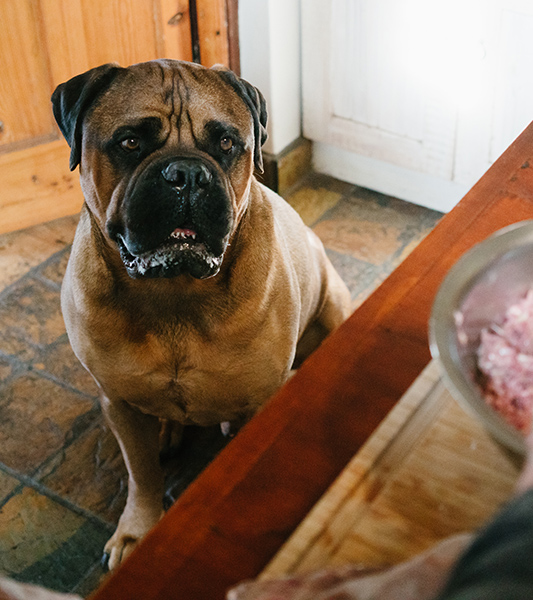
We want to focus on telling you why raw feeding is good rather than detailing why dry food is bad – but a brief look at the history of commercial pet food certainly makes for interesting reading. There are many articles available online if you want to know more – we don’t want to simply repeat what they say here, but NYC Dogs lays out the history and much of the nutritional science in a palatable and easy read.The short version is that pellets/kibble have only been widely used since the 1950’s when corporations discovered the enormous profits that could be made in the pet food industry via the technology of heat extrusion (where the food is processed at excessively high temperatures – yes, it kills bacteria, but it also kills most of the nutrition, including the live enzymes that would have contributed to a healthy immune system in their original, raw form). Already in the 1930’s, when most commercial pet food was canned and horse-meat based, the Natural Pet-Rearing Movement was started by the herbalist Juliette de Bairacli Levy. She promoted a diet of raw food for dogs and cats, and the treatment of ailments via natural remedies.
In 1993, Dr Ian Billinghurst published his work about the illnesses that have arisen since pellets became the staple pet food, and since then the modern natural feeding movement has been joyfully spreading. Dr Billinghurst is an avid advocate for feeding dogs and cats “Biologically Appropriate Raw Food” (BARF). Both Billinghurst, and Dr Tom Lonsdale (2001) researched the diets of wolves and wild dogs and showed us that the natural meal plan of our dogs’ ancestors can help us to keep our beloved pets as happy and healthy as they were meant to be. “Dogs are modified wolves and cats are modified desert predators,” says Dr Lonsdale. He asserts that feeding your pet only on commercial dry pet food is the equivalent of feeding your children fast food at every meal.
Other brilliant vets like Dr Jean Dodds, Dr. Mark Roberts, Dr Holly Mash, and Dr Karen Becker from the Raw Feeding Veterinary Society have taken this research further and we find their publications and talks very useful. Animal nutritionists like Dr. Conor Brady, Michelle Bernard, Kymythy Schultze, and many others have all contributed to our knowledge.
For cats in particular, there is an advocacy group called The Feline Nutrition Education Society – their website is packed with informative and inspiring articles.
If you’re looking for a vet who supports raw feeding in South Africa, look at the Complementary Veterinary Medicine Group. And the list goes on, as the research goes on.
The core philosophy that we and all the above-mentioned and many other writers, researchers, and vets share is that optimal pet health will only be obtained if we mimic the species-appropriate ancestral diets that our pets would eat in nature. They are natural creatures, after all.
Are Potatoes Good For Dogs? (And Other Questions About Starch). By: Dana Scott - Reading Time: 9 minutes Updated On May 4, 20202
Are Potatoes Good For Dogs? (And Other Questions About Starch)
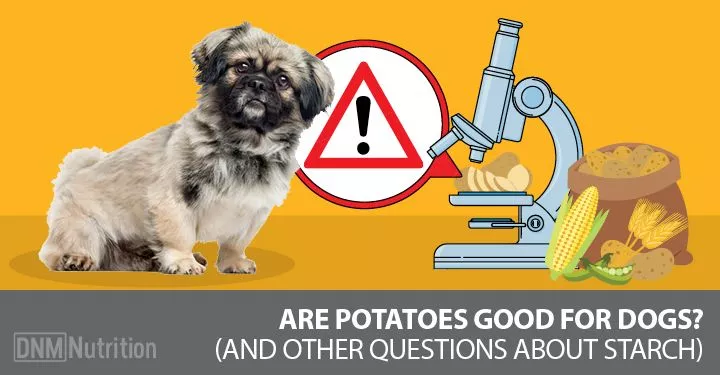
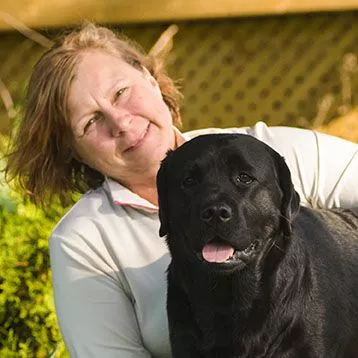
By: Dana Scott - Reading Time: 9 minutesUpdated On May 4, 2020
Are potatoes good for dogs? Can my dog eat peas? Is a dog food OK as long as it doesn’t have corn, soy or wheat?
These are really common questions here at DNM and they’re valid ones. You want to avoid feeding harmful ingredients to your dog and that’s a good thing. But there’s a lot of marketing out there telling you some carbohydrates (like potatoes and peas) are a healthy addition to your dog’s diet.
But here’s the problem … that marketing is from people who want to sell you their food.
The truth is, there are some pretty compelling reasons not to feed any type of starchy carbohydrate to dogs. Let’s look at the top reasons to avoid starch …
#1 Mycotoxins
Mycotoxins are toxic byproducts of mold or fungus. Mycotoxins contaminate crops before they’re harvested or after they’re stored. They’re most commonly found in corn, barley, wheat, beets, peanuts and cottonseed, but other frequently affected foods include; sorghum, pearl millet, rice, wheat, soybean and sunflower seeds.
One of the most well-known mycotoxins is aflatoxin … and it’s the most carcinogenic (cancer-causing) naturally occurring substance known to man. A global survey conducted between 2004 and 2013 found mycotoxin contamination in over 76% of the samples of grains and byproducts destined for animal foods.
Aflatoxins target many of the organs in dogs but especially the liver, where they can cause toxicity, immunosuppression and cancer.
In the US, both human and pet foods are limited to 20ug of mycotoxin per kg. But grains usually contain several different types of mycotoxins and they can interact with one another to increase their toxicity. And the effects of mycotoxin exposure are cumulative and build up in your pet over time.
A 2015 study published in Animal Feed Science & Technology analyzed 48 commercial dry dog foods for the presence of five different mycotoxins. Half of the foods tested were low price and the other half were premium or super-premium foods.
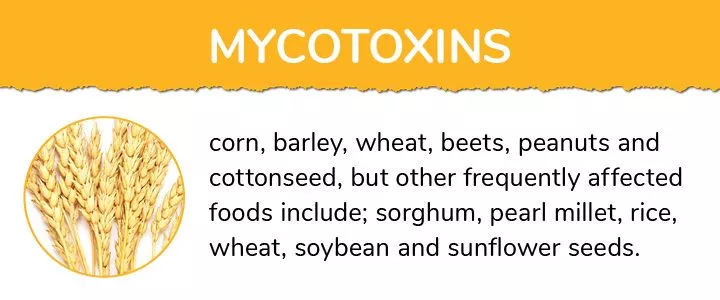
The study found that all of the lower priced foods and all but one of the premium foods were contaminated with at least two types of mycotoxin. Additionally, 52% of the samples were contaminated with three different mycotoxins while 25% were contaminated with four different types of mycotoxin. One premium brand was contaminated with all five mycotoxins that were tested for.Many pet food companies test their ingredients for mycotoxin contamination and ask their suppliers for a certificate of analysis showing mycotoxins have been checked. But even if the food is under the allowable FDA limit, it doesn’t account for the dangers of combining mycotoxins. When more than one type of mycotoxin is present, they can interact and become more toxic – so the safe limit is likely only safe if there’s one type of mycotoxin present.Dr Trevor Smith, an animal and poultry science researcher at the University of Guelph, claims that mycotoxin contamination is the largest concern in pet foods today. According to Smith, “when half of the food is of vegetable origin, there will always be some degree of contamination. If the food is mainly of animal origin, the chances of contamination are greatly reduced.”
#2 Antinutrients
Antinutrients are naturally occurring or man-made substances in food that can interfere with the absorption of vitamins, minerals and other nutrients, and interfere with digestive enzymes. In a nutshell, they can rob your dog of nutrition. Antinutrients are most commonly found in grains, beans, legumes and nuts.
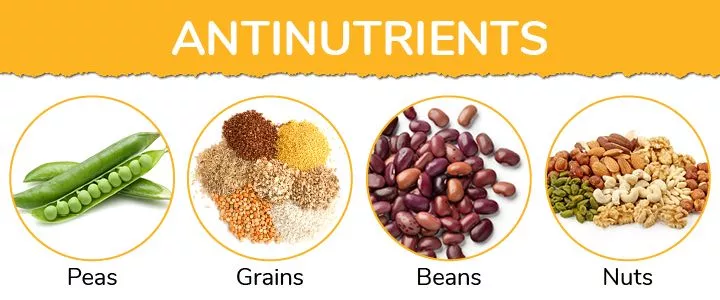
These include:1. Phytic Acid (Or Phytate)Phytic acid is found in grains and legumes (like peas, which are commonly found in grain-free pet foods). It’s an antinutrient because it can bind to important minerals such as copper, iron, magnesium and zinc, and make them unavailable to your dog. Phytic acid can rob your dog of up to 80% of these critical nutrients.
2. Lectins
Lectins are found in large amounts in beans and some grains and, like phytic acid, can also reduce nutrient absorption. But lectins can do more damage than that … they can damage the cells that line your dog’s intestines. When this happens, the ability of nutrients to be able to pass through your dog’s intestines and into his body are affected. It can also disrupt the delicate balance of flora living there and trigger allergy and autoimmune reactions.
There are many other anti nutrients in grains and starches, including gluten (which can cause leaky gut syndrome and autoimmune disease), tannins (which can upset the gastrointestinal tract) and oxalates (which can cause kidney stones).
#3 Glycemic Load

The glycemic load of foods is an indication of how quickly it raises the blood sugar. A small, steady amount of carbohydrate or starch in the diet is fairly harmless, but when large amounts of starchy carbohydrate are added to the diet (and most dry dog foods are 30-60% carbohydrate), this can cause obesity and insulin resistance.Insulin is a hormone found in all humans, dogs and cats. One of insulin’s primary purposes is to get sugar from the blood into the cells. Insulin is the only hormone that does this.On the other hand, your dog has multiple hormones that raise blood sugar … and this tells us a lot about the type of diet dogs are designed to eat. The body is much better prepared to raise blood sugar when carbohydrate is scarce, than it is to lower it when too much carbohydrate is eaten.
When your dog eats carbohydrates, they’re broken down into glucose, which is the form the body can use for fuel. When this happens, insulin is released to move the blood sugar, or glucose, into the cells. And how quickly this happens is the food’s glycemic load.
The only foods that cause a quick spike in glucose and insulin secretion are carbohydrates.
Why is spiking insulin unhealthy?
Over time, the dog’s body will become less sensitive to insulin and insulin resistance can occur. And that’s bad because the pancreas will have to work harder to produce more and more insulin and can become exhausted … and your dog can develop diabetes.
But that’s not the only risk. Insulin resistance can also increase the risk of thyroid disease and some types of cancer. And because one of insulin’s jobs is to store body fat, the dog eating a lot of carbohydrate can become fat … and you’ll find it really hard to take the weight off.
Other Dangers Of Carbohydrate
There are 6 key reasons to avoid starchy carbs in your dog’s diet.
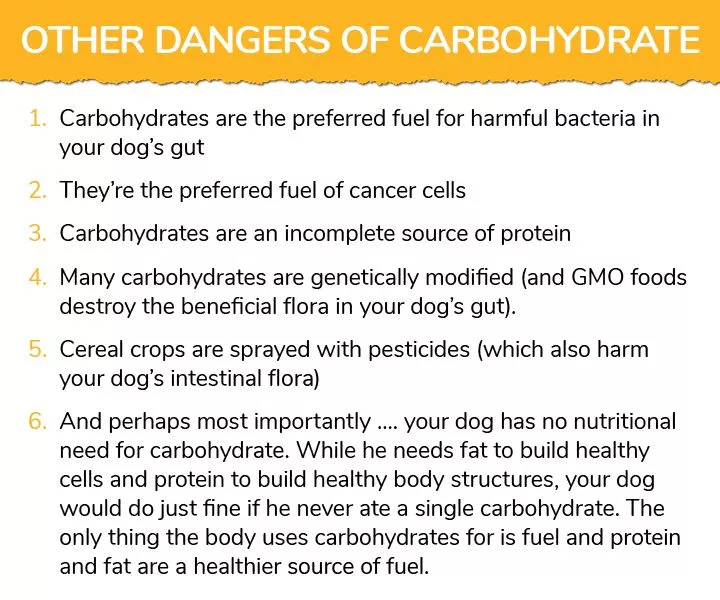
Given this, you’d think most commercial pet foods would steer clear of carbohydrates. But they don’t! Why Are Carbs In So Many Foods And Treats? Why are carbohydrates in so many dog foods and treats?
They’re cheap.
Let’s face it, pet foods can be expensive and carbohydrates can provide energy without adding much cost. But because they’re so nutritionally incomplete, you’ll also see other ingredients added to dog foods to make up for the lack of nutrition in the carbs. So you’ll see:
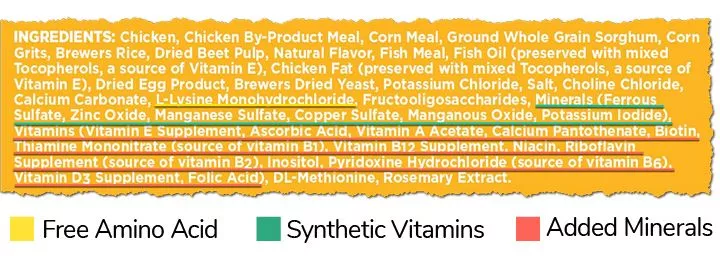
Cutting Back On The Carbs
Ready to cut the carbs out of your dog’s diet? Here are some solutions, listed in order from most desirable to least desirable …
1. Feed A Raw Diet
There’s nothing magical about raw diets … the only reason raw feeders see fewer health issues in their dogs is because they don’t contain starchy carbohydrates. Fruits and vegetables are fine … they don’t contain phytic acid, they have a low glycemic load and they can be loaded with vitamins and minerals. But raw diets are free of peas, potatoes and cereal grains and that’s why so many dogs do so well on them.
2. Cook For Your Dog
This is a tough one because so many cooked diets are loaded with carbohydrates. Fresh foods are always better than processed foods, so if you cook for your dog, try to keep the carbohydrates to less than 10% of the diet and load your dog up on protein and fat instead.
3. Feed A Low Starch Dog Food
Note that I didn’t say feed a grain-free diet. Grain-free diets can be higher in starch than regular foods … they just replace the grains with potatoes and peas.
What you’ll want to find is a food with the least amount of carbohydrate … and that means no more than 15%. The problem is, pet food manufacturers aren’t forced to tell you how much carbohydrate is in the food … so they don’t!
Fortunately, it’s pretty easy to calculate the amount of carbohydrate in your dog’s food.

Flip your bag of dog food over and you’ll find something called the Guaranteed Analysis. This is the guaranteed minimum amounts of certain nutrients in the food. Next, find the percentage of protein, fat, moisture and ash and then add them together.If the ash content isn’t listed on the food, just use 7% for kibble and 2% for canned food. Ash content can vary but for most dry foods it typically ranges from 5% to 8%.Subtract that total from 100 and that will give you the percentage of carbohydrate in the food. Here’s the math:
Let’s look at a couple of random examples … a regular dry food and a grain-free food (these are completely random and are not an endorsement of any kind).
Here is from Gold Holistic Large Breed Adult Dry Dog Food
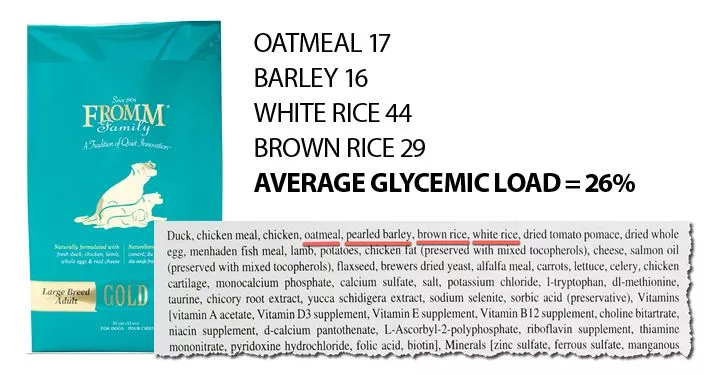 If you turn the bag over, you’ll find the Guaranteed Analysis. So let’s plug the numbers in.100 – (23 (Protein) + 12 (Fat) + 10 (Moisture) + 7 (Ash)) = 48% CarbohydrateNext let’s look at another food: Addiction Grain-Free Salmon Bleu Dry Dog Food.
If you turn the bag over, you’ll find the Guaranteed Analysis. So let’s plug the numbers in.100 – (23 (Protein) + 12 (Fat) + 10 (Moisture) + 7 (Ash)) = 48% CarbohydrateNext let’s look at another food: Addiction Grain-Free Salmon Bleu Dry Dog Food.
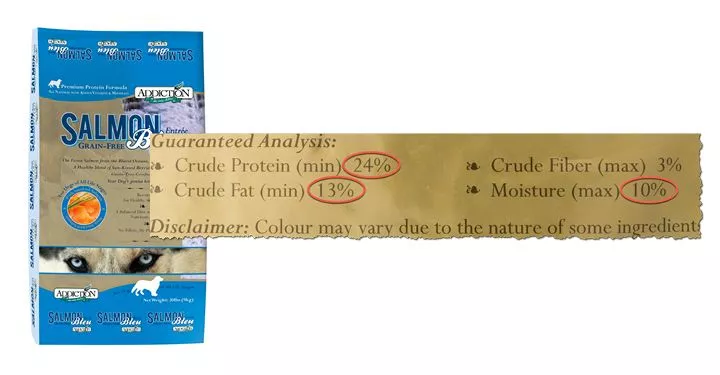
Let’s see what the carbohydrate content is in this food:100 – (24 (Protein) + 13 (Fat) + 10 (Moisture) + 10 (Ash)) = 43% Carbohydrate
You can see that both these foods are very high in carbohydrate. Again, you’ll want to keep your carbs under 15% (and if you start looking at foods, you’ll see that’s a very rare find).
What Happens If You Do Nothing?
The worst thing you can do is to keep doing what you’re doing because your dog “appears” to be healthy. Whether it be weeks, months or years from now, you and your vet probably won’t make the connection between his allergies, cancer, liver or kidney disease, and the lifetime of eating an unnecessary food that can cause very real health issues if it’s fed in excess.
If kibble is all you can afford, then try to add some protein or healthy fat (like hemp oil, eggs or whole fish) to your dog’s diet … at the minimum it will lower the glycemic load and replace some of the missing vitamins and minerals. But doing nothing is setting your dog up to fail.
Don’t rely on pet food companies to tell you what’s right for your dog … even the best companies have to care about their financial health before they can ever consider your dog’s health. Quality ingredients cost money and most dog owners aren’t prepared to pay that price for their dog’s food. Hopefully you’re an exception and you’ll start to see the connection between your dog’s health and the foods that you give him.
Dana Scott
Dana Scott is the Founder and Editor in Chief of Dogs Naturally Magazine and CEO of Four Leaf Rover, a high end natural supplement company. She also breeds award winning Labrador Retrievers under the Fallriver prefix. Dana has been a raw feeding, natural rearing breeder since the 90's and is a sought after speaker and outspoken advocate for natural health care for dogs and people. Dana works tirelessly to educate pet owners so they can influence veterinary medicine and change current vaccine, food and preventive health practices.


By: Dana Scott - Reading Time: 9 minutesUpdated On May 4, 2020
Are potatoes good for dogs? Can my dog eat peas? Is a dog food OK as long as it doesn’t have corn, soy or wheat?
These are really common questions here at DNM and they’re valid ones. You want to avoid feeding harmful ingredients to your dog and that’s a good thing. But there’s a lot of marketing out there telling you some carbohydrates (like potatoes and peas) are a healthy addition to your dog’s diet.
But here’s the problem … that marketing is from people who want to sell you their food.
The truth is, there are some pretty compelling reasons not to feed any type of starchy carbohydrate to dogs. Let’s look at the top reasons to avoid starch …
#1 Mycotoxins
Mycotoxins are toxic byproducts of mold or fungus. Mycotoxins contaminate crops before they’re harvested or after they’re stored. They’re most commonly found in corn, barley, wheat, beets, peanuts and cottonseed, but other frequently affected foods include; sorghum, pearl millet, rice, wheat, soybean and sunflower seeds.
One of the most well-known mycotoxins is aflatoxin … and it’s the most carcinogenic (cancer-causing) naturally occurring substance known to man. A global survey conducted between 2004 and 2013 found mycotoxin contamination in over 76% of the samples of grains and byproducts destined for animal foods.
Aflatoxins target many of the organs in dogs but especially the liver, where they can cause toxicity, immunosuppression and cancer.
In the US, both human and pet foods are limited to 20ug of mycotoxin per kg. But grains usually contain several different types of mycotoxins and they can interact with one another to increase their toxicity. And the effects of mycotoxin exposure are cumulative and build up in your pet over time.
A 2015 study published in Animal Feed Science & Technology analyzed 48 commercial dry dog foods for the presence of five different mycotoxins. Half of the foods tested were low price and the other half were premium or super-premium foods.

The study found that all of the lower priced foods and all but one of the premium foods were contaminated with at least two types of mycotoxin. Additionally, 52% of the samples were contaminated with three different mycotoxins while 25% were contaminated with four different types of mycotoxin. One premium brand was contaminated with all five mycotoxins that were tested for.Many pet food companies test their ingredients for mycotoxin contamination and ask their suppliers for a certificate of analysis showing mycotoxins have been checked. But even if the food is under the allowable FDA limit, it doesn’t account for the dangers of combining mycotoxins. When more than one type of mycotoxin is present, they can interact and become more toxic – so the safe limit is likely only safe if there’s one type of mycotoxin present.Dr Trevor Smith, an animal and poultry science researcher at the University of Guelph, claims that mycotoxin contamination is the largest concern in pet foods today. According to Smith, “when half of the food is of vegetable origin, there will always be some degree of contamination. If the food is mainly of animal origin, the chances of contamination are greatly reduced.”
#2 Antinutrients
Antinutrients are naturally occurring or man-made substances in food that can interfere with the absorption of vitamins, minerals and other nutrients, and interfere with digestive enzymes. In a nutshell, they can rob your dog of nutrition. Antinutrients are most commonly found in grains, beans, legumes and nuts.

These include:1. Phytic Acid (Or Phytate)Phytic acid is found in grains and legumes (like peas, which are commonly found in grain-free pet foods). It’s an antinutrient because it can bind to important minerals such as copper, iron, magnesium and zinc, and make them unavailable to your dog. Phytic acid can rob your dog of up to 80% of these critical nutrients.
2. Lectins
Lectins are found in large amounts in beans and some grains and, like phytic acid, can also reduce nutrient absorption. But lectins can do more damage than that … they can damage the cells that line your dog’s intestines. When this happens, the ability of nutrients to be able to pass through your dog’s intestines and into his body are affected. It can also disrupt the delicate balance of flora living there and trigger allergy and autoimmune reactions.
There are many other anti nutrients in grains and starches, including gluten (which can cause leaky gut syndrome and autoimmune disease), tannins (which can upset the gastrointestinal tract) and oxalates (which can cause kidney stones).
#3 Glycemic Load

The glycemic load of foods is an indication of how quickly it raises the blood sugar. A small, steady amount of carbohydrate or starch in the diet is fairly harmless, but when large amounts of starchy carbohydrate are added to the diet (and most dry dog foods are 30-60% carbohydrate), this can cause obesity and insulin resistance.Insulin is a hormone found in all humans, dogs and cats. One of insulin’s primary purposes is to get sugar from the blood into the cells. Insulin is the only hormone that does this.On the other hand, your dog has multiple hormones that raise blood sugar … and this tells us a lot about the type of diet dogs are designed to eat. The body is much better prepared to raise blood sugar when carbohydrate is scarce, than it is to lower it when too much carbohydrate is eaten.
When your dog eats carbohydrates, they’re broken down into glucose, which is the form the body can use for fuel. When this happens, insulin is released to move the blood sugar, or glucose, into the cells. And how quickly this happens is the food’s glycemic load.
The only foods that cause a quick spike in glucose and insulin secretion are carbohydrates.
Why is spiking insulin unhealthy?
Over time, the dog’s body will become less sensitive to insulin and insulin resistance can occur. And that’s bad because the pancreas will have to work harder to produce more and more insulin and can become exhausted … and your dog can develop diabetes.
But that’s not the only risk. Insulin resistance can also increase the risk of thyroid disease and some types of cancer. And because one of insulin’s jobs is to store body fat, the dog eating a lot of carbohydrate can become fat … and you’ll find it really hard to take the weight off.
Other Dangers Of Carbohydrate
There are 6 key reasons to avoid starchy carbs in your dog’s diet.

Given this, you’d think most commercial pet foods would steer clear of carbohydrates. But they don’t! Why Are Carbs In So Many Foods And Treats? Why are carbohydrates in so many dog foods and treats?
They’re cheap.
Let’s face it, pet foods can be expensive and carbohydrates can provide energy without adding much cost. But because they’re so nutritionally incomplete, you’ll also see other ingredients added to dog foods to make up for the lack of nutrition in the carbs. So you’ll see:

- Added vitamins
- Added minerals
- Added free amino acids (because carbohydrates are an incomplete source of protein)
Cutting Back On The Carbs
Ready to cut the carbs out of your dog’s diet? Here are some solutions, listed in order from most desirable to least desirable …
1. Feed A Raw Diet
There’s nothing magical about raw diets … the only reason raw feeders see fewer health issues in their dogs is because they don’t contain starchy carbohydrates. Fruits and vegetables are fine … they don’t contain phytic acid, they have a low glycemic load and they can be loaded with vitamins and minerals. But raw diets are free of peas, potatoes and cereal grains and that’s why so many dogs do so well on them.
2. Cook For Your Dog
This is a tough one because so many cooked diets are loaded with carbohydrates. Fresh foods are always better than processed foods, so if you cook for your dog, try to keep the carbohydrates to less than 10% of the diet and load your dog up on protein and fat instead.
3. Feed A Low Starch Dog Food
Note that I didn’t say feed a grain-free diet. Grain-free diets can be higher in starch than regular foods … they just replace the grains with potatoes and peas.
What you’ll want to find is a food with the least amount of carbohydrate … and that means no more than 15%. The problem is, pet food manufacturers aren’t forced to tell you how much carbohydrate is in the food … so they don’t!
Fortunately, it’s pretty easy to calculate the amount of carbohydrate in your dog’s food.

Flip your bag of dog food over and you’ll find something called the Guaranteed Analysis. This is the guaranteed minimum amounts of certain nutrients in the food. Next, find the percentage of protein, fat, moisture and ash and then add them together.If the ash content isn’t listed on the food, just use 7% for kibble and 2% for canned food. Ash content can vary but for most dry foods it typically ranges from 5% to 8%.Subtract that total from 100 and that will give you the percentage of carbohydrate in the food. Here’s the math:
Let’s look at a couple of random examples … a regular dry food and a grain-free food (these are completely random and are not an endorsement of any kind).
Here is from Gold Holistic Large Breed Adult Dry Dog Food
 If you turn the bag over, you’ll find the Guaranteed Analysis. So let’s plug the numbers in.100 – (23 (Protein) + 12 (Fat) + 10 (Moisture) + 7 (Ash)) = 48% CarbohydrateNext let’s look at another food: Addiction Grain-Free Salmon Bleu Dry Dog Food.
If you turn the bag over, you’ll find the Guaranteed Analysis. So let’s plug the numbers in.100 – (23 (Protein) + 12 (Fat) + 10 (Moisture) + 7 (Ash)) = 48% CarbohydrateNext let’s look at another food: Addiction Grain-Free Salmon Bleu Dry Dog Food.
Let’s see what the carbohydrate content is in this food:100 – (24 (Protein) + 13 (Fat) + 10 (Moisture) + 10 (Ash)) = 43% Carbohydrate
You can see that both these foods are very high in carbohydrate. Again, you’ll want to keep your carbs under 15% (and if you start looking at foods, you’ll see that’s a very rare find).
What Happens If You Do Nothing?
The worst thing you can do is to keep doing what you’re doing because your dog “appears” to be healthy. Whether it be weeks, months or years from now, you and your vet probably won’t make the connection between his allergies, cancer, liver or kidney disease, and the lifetime of eating an unnecessary food that can cause very real health issues if it’s fed in excess.
If kibble is all you can afford, then try to add some protein or healthy fat (like hemp oil, eggs or whole fish) to your dog’s diet … at the minimum it will lower the glycemic load and replace some of the missing vitamins and minerals. But doing nothing is setting your dog up to fail.
Don’t rely on pet food companies to tell you what’s right for your dog … even the best companies have to care about their financial health before they can ever consider your dog’s health. Quality ingredients cost money and most dog owners aren’t prepared to pay that price for their dog’s food. Hopefully you’re an exception and you’ll start to see the connection between your dog’s health and the foods that you give him.
Dana Scott
Dana Scott is the Founder and Editor in Chief of Dogs Naturally Magazine and CEO of Four Leaf Rover, a high end natural supplement company. She also breeds award winning Labrador Retrievers under the Fallriver prefix. Dana has been a raw feeding, natural rearing breeder since the 90's and is a sought after speaker and outspoken advocate for natural health care for dogs and people. Dana works tirelessly to educate pet owners so they can influence veterinary medicine and change current vaccine, food and preventive health practices.
Don't Poo-Poo This: Why Dogs Feast on Feces By Mindy Weisberger - Senior Writer January 19, 2018

The fresher the poop, the more likely a dog will eat it — whether you like it or not.(Image: © Shutterstock)
Scientists recently dug into the patterns of crap-consuming canines and flushed out an answer.
It turns out that not just any old poo will do. For poop-seeking pups, fecal freshness is a factor. And this predilection for poop could be behavior that originated in dogs' wolf ancestors, and is linked to parasite prevention, according to a new study.
Also known as coprophagia, poop eating is widely distributed across the mammal family tree. The behavior — which is also found in rodents, rabbits, beavers, elephants and non-human primates, to name just a few — is generally viewed as a second chance for an animal to extract nutrients from its diet. Domestic dogs, which can also be avid eaters of poop, have been found to turn to poop eating due to nutritional deficiencies in their diets caused by starvation or disease, prior research has suggested.
However, that doesn't explain why otherwise healthy dogs would develop a taste for waste. Puppies may learn this behavior from their mothers, who lick their babies when they are very young to encourage elimination and to clean them up afterward. But most dogs tend to grow out of this youthful poop-eating stage by the time they are 9 months old, according to the American Kennel Club.
What makes this behavior even more puzzling is that dogs generally distance themselves from their own droppings and those of other dogs, researchers reported in the new study. This avoidance may stem from ancestral wolves' habits of eliminating outside their dens, perhaps to reduce the risk of infection from parasites found in their stools, the researchers suggested.
Fresher is better
To get to the bottom of why dogs eat feces, the scientists conducted two online surveys, gathering about 3,000 responses from dog owners in the U.S. and Canada. One survey investigated the habits of dogs that ate poop and dogs that didn't, while the other addressed only the poo eaters, to gather data about frequency, persistence of the behavior and the type of poop that attracted them the most.
About 16 percent of responders to the first survey said that they had observed their dog eating poop, and feces feasting did not appear to be linked to generally compulsive behavior or dietary deficiencies.
Interestingly, 82 percent of the poo eaters only consumed poop that was no more than 2 days old, the study authors reported.
This preference emerged in both surveys, and could be an important clue to the origins of poop-eating behavior, linking it to an adaptive behavior practiced by the ancestors of domestic dogs — wolves, the study authors reported.
Wolves expel the eggs of intestinal parasites such as tapeworms, roundworms, pinworms and flukes in their feces, and these eggs typically don't develop into an infectious larval form for several days. By eating fresh poop found in or near their den areas, wolves may perform a type of housekeeping that reduces the risk of parasitic infection, the researchers explained in the study.
However, this hypothesis for the origins of poop eating in dogs doesn't draw from observed behavior in wolves, "and should be considered tentative," the study authors wrote.
Another unsatisfying conclusion for disgruntled dog owners is that pooches' poop-eating habits are hard to change, the scientists found.
They discovered that dogs who fancied feces weren't easily deterred, and regardless of the method owners tried — food additives, punishment for eating poo or rewards for leaving poop alone — their reported success rate was 0 to 4 percent.
The findings were published online Jan. 12 in the journal Veterinary Medicine and Science.
Original article on Live Science.
10 Things You Didn't Know About Dogs by https://www.livescience.com/
Doggie Facts

Dog accompanies his master on a fishing excursion. (Image credit: Steve Hillebrand, US Fish and Wildlife Service)
Dogs and humans have been living side-by-side for about 15,000 years, so you might think we know each other pretty well. But there's more to dogs than fetching and playing dead. Here are some little-known facts about man's best friend.
Dogs get our diseases ...

Veterinarian with a beagle puppy. (Image credit: Credit line (HTML Code): © Amaviael | Dreamstime.com)
Humans and canines aren't so different after all, at least regarding what makes us sick. About 6 million dogs are diagnosed with cancer each year, and dogs get canine versions of rare human disorders like the brain-wasting neuronal ceroid lipofuscinosis that leads to the inability to walk or control their muscles. While illness is sad for humans and pets alike, sharing diseases benefits both species. Clinical trials are easier to run on pets, giving doctors an animal model of human disease -- and Fido a chance for a cure....
And they can smell our diseases, too

A dog named Pepper was trained to detect dung of the rare Javan rhino in the forests of Vietnam as part of a WWF project aimed at estimating the remaining population. (Image credit: © WWF Greater Mekong.)If you have cancer, diabetes, or epilepsy, your dog might be the first to know. Studies have shown that dogs can be trained to sniff out cancers of the lung, breast, skin, bladder and prostate.
Researchers suspect the canines are picking up on extraordinarily faint scents given off by the abnormal cells.Dogs are also being increasingly used as service animals for people with diabetes, whose health can be harmed when their blood sugar peaks or drops. Specially trained dogs can detect the scent of these fluctuations (sweet for high blood sugar, acidic for low) and alert their owners before they even feel symptoms.
Most mysterious of all are scattered reports that dogs can predict an epileptic seizure 45 minutes before it begins. No one knows what the dogs might be picking up on, but theories range from an unknown smell to subtle behavioral changes.
See Spot think

Babies as young as six months old can distinguish between friendly dog barks and threatening ones. (Image credit: Mark Philbrick/BYU.)
Dogs can be as smart as 2-year-old children, according to research presented in 2009 at a meeting of the American Psychological Association. Border collies are the top dogs in the intelligence category, with some in the breed capable of understanding up to 200 words. Poodles, German shepherds, Golden retrievers and Dobermans round out the top five smartest breeds. (The most popular breed in America, the Labrador retriever, comes in at number seven.) Older breeds like hound dogs, bulldogs and beagles are among the slow learners of the doggie world, the researchers reported.
Unlike newer dog breeds, which are designed for companionship and sociability, old breeds were bred to sniff and hunt, perhaps giving them more brawn than brain.
Your furball can make you sick

Can a dog's mouth really be cleaner than a human's, despite all the leftover macaroni, rubber bands and dead squirrels dogs chew? (Image credit: Caroline Kjall/stock.xchng) We've all heard the canard that dogs' mouths are cleaner than humans (they're not), but in reality, dogs can carry pathogens that harm humans. Rabies, a fatal neurological disease, is the most famous (remember Old Yeller?), though vaccines, mandated by law in most states, can stop the spread. In a few cases, dog food has been known to cause food poisoning in humans, thanks to contamination by Salmonella bacteria. Perhaps creepiest of all is a 2003 study published in The Veterinary Record, which found that humans could contract the parasitic roundworm Toxocara canis just be stroking an infected dogs' fur. The roundworm, which grows in dogs' intestines, can grow in the back of the eye in humans, causing blindness. They also sometimes take up residence in human livers and lungs.
Roundworm infections in humans are rare, and proper veterinary care can ensure that dogs stay worm-free. Still, British veterinarian and study co-author told New Scientist magazine in 2003, hygiene is important for dog owners. "Wash your hands before meals," he told the magazine, "and after a good cuddle."
Dogs feel envy ...

The subject is following closely that the partner is receiving a food reward for its action. (Image credit: Friederike Range)Dogs know when they're not getting a fair shake. A 2008 study published in the journal Proceedings of the National Academy of Sciences found that when dogs saw other dogs getting treats for a trick they'd been performing unrewarded, the unrewarded dogs became agitated, scratching themselves and avoiding the gaze of the rewarded dogs. They also stopped doing the trick much faster than if they were alone and not getting a reward.
The dogs' version of jealousy wasn't as sophisticated as a human's: The animals didn't seem to mind if other dogs got sausage while they just got bread, and they didn't care if another dog got food for nothing while they had to do tricks for a snack. But, the researchers wrote, the findings were good evidence that being green with envy isn't just a primate thing.
... But not guilt

(Image credit: stockxpert)
Those puppy-dog eyes Fido gives you when you scold him over knocking over the garbage can for the umpteenth time aren’t a sign of guilt, researchers say. He's just responding to your rebuke. When dog owners thought their dogs had eaten a forbidden treat and reprimanded them, the pooches looked just as "guilty" regardless of whether or not they had actually eaten the treat. In fact, dogs who were wrongly accused of snack-snatching often looked more guilty than dogs who had really eaten the treat. Turns out those soulful eyes don't reflect any soul-searching, after all.
Docile dogs live longer

Little girl kissing a Golden Retriever puppy. (Image credit: Dreamstime.)
On the other hand, if your dog stays out of the garbage, it may be in for a longer life. Obedient, docile dog breeds live longer, according to research published in June 2010 in The American Naturalist. The study compared the energy use, personalities, growth rates and life spans of 56 dog breeds. After controlling for factors like body size, the researchers found that bold, aggressive breeds lived fast and died young. They grew faster than obedient, eager-to-please breeds, and also had higher energy needs. The findings suggest that in selectively breeding for personality, humans inadvertently tapped into linked traits like metabolism and longevity.
Dogs are the most diverse-looking mammals around

Of two Chinese Shar-Pei littermates, one (left) exhibits extensive skin wrinkling. (Image credit: Alison L. Ruhe)
From the droopy Bassett hound to the sleek-and-slim Weimaraner, dogs show an amazing diversity in body shape. A study published in The American Naturalist in 2010 found that the differences between dog breeds' skulls are as pronounced as the differences between completely separate mammal species. A Collie skull, for example, is as different from a Pekingese skull as a cat's skull is from a walrus's.All of this diversity makes dogs a great species for studying how genes work, allowing researchers to link genes to certain traits -- like what makes Shar-Peis wrinkly and dachshunds so stubby.
Lassie, religious icon or social glue?

Ashley, Jennie and Pickles exercise together while trainer Cindy Hauss looks on. 'It doesn't necessarily have to be complicated,' said Vogelsang. 'At the end of the day, it's calories in, calories out.' (Image credit: Robin Manresa)
In ancient times, people saw dogs as more than useful animals; dogs also had a spiritual role. The three-headed hound called Cerberus guarded the underworld in Greek myth, while the ancient Egyptian embalmers took Anubis, the jackel-headed god, as their patron. In Mayan folklore, dogs were believed to lead the dead to the afterlife. In Nepal, the autumn festival of Tihar sets aside a day to honor dogs with flower garlands and food.Nowadays, dogs are more likely to be seen as pets than religious figures, but people are still crazy about canines. According to a 2009-2010 survey by the American Pet Products Manufacturers Association, 39 percent of American households have at least one dog for a total of over 77 million pet dogs hunkered down in American homes. In one recent survey, 80 percent of dog owners reported interacting with their dogs for more than two hours a day. Many reported viewing their pets as their children.
Man's best friend may even net you more human friends. A 2000 study published in journal of The British Psychological Society found that walking with a dog at least tripled the number of social interactions a person had. Unfashionable pet owners take heart: The dogs elicited positive social contact even when the animal looked fierce or the owner dressed in shabby clothes.

Dog accompanies his master on a fishing excursion. (Image credit: Steve Hillebrand, US Fish and Wildlife Service)
Dogs and humans have been living side-by-side for about 15,000 years, so you might think we know each other pretty well. But there's more to dogs than fetching and playing dead. Here are some little-known facts about man's best friend.
Dogs get our diseases ...

Veterinarian with a beagle puppy. (Image credit: Credit line (HTML Code): © Amaviael | Dreamstime.com)
Humans and canines aren't so different after all, at least regarding what makes us sick. About 6 million dogs are diagnosed with cancer each year, and dogs get canine versions of rare human disorders like the brain-wasting neuronal ceroid lipofuscinosis that leads to the inability to walk or control their muscles. While illness is sad for humans and pets alike, sharing diseases benefits both species. Clinical trials are easier to run on pets, giving doctors an animal model of human disease -- and Fido a chance for a cure....
And they can smell our diseases, too

A dog named Pepper was trained to detect dung of the rare Javan rhino in the forests of Vietnam as part of a WWF project aimed at estimating the remaining population. (Image credit: © WWF Greater Mekong.)If you have cancer, diabetes, or epilepsy, your dog might be the first to know. Studies have shown that dogs can be trained to sniff out cancers of the lung, breast, skin, bladder and prostate.
Researchers suspect the canines are picking up on extraordinarily faint scents given off by the abnormal cells.Dogs are also being increasingly used as service animals for people with diabetes, whose health can be harmed when their blood sugar peaks or drops. Specially trained dogs can detect the scent of these fluctuations (sweet for high blood sugar, acidic for low) and alert their owners before they even feel symptoms.
Most mysterious of all are scattered reports that dogs can predict an epileptic seizure 45 minutes before it begins. No one knows what the dogs might be picking up on, but theories range from an unknown smell to subtle behavioral changes.
See Spot think

Babies as young as six months old can distinguish between friendly dog barks and threatening ones. (Image credit: Mark Philbrick/BYU.)
Dogs can be as smart as 2-year-old children, according to research presented in 2009 at a meeting of the American Psychological Association. Border collies are the top dogs in the intelligence category, with some in the breed capable of understanding up to 200 words. Poodles, German shepherds, Golden retrievers and Dobermans round out the top five smartest breeds. (The most popular breed in America, the Labrador retriever, comes in at number seven.) Older breeds like hound dogs, bulldogs and beagles are among the slow learners of the doggie world, the researchers reported.
Unlike newer dog breeds, which are designed for companionship and sociability, old breeds were bred to sniff and hunt, perhaps giving them more brawn than brain.
Your furball can make you sick

Can a dog's mouth really be cleaner than a human's, despite all the leftover macaroni, rubber bands and dead squirrels dogs chew? (Image credit: Caroline Kjall/stock.xchng) We've all heard the canard that dogs' mouths are cleaner than humans (they're not), but in reality, dogs can carry pathogens that harm humans. Rabies, a fatal neurological disease, is the most famous (remember Old Yeller?), though vaccines, mandated by law in most states, can stop the spread. In a few cases, dog food has been known to cause food poisoning in humans, thanks to contamination by Salmonella bacteria. Perhaps creepiest of all is a 2003 study published in The Veterinary Record, which found that humans could contract the parasitic roundworm Toxocara canis just be stroking an infected dogs' fur. The roundworm, which grows in dogs' intestines, can grow in the back of the eye in humans, causing blindness. They also sometimes take up residence in human livers and lungs.
Dogs feel envy ...

The subject is following closely that the partner is receiving a food reward for its action. (Image credit: Friederike Range)Dogs know when they're not getting a fair shake. A 2008 study published in the journal Proceedings of the National Academy of Sciences found that when dogs saw other dogs getting treats for a trick they'd been performing unrewarded, the unrewarded dogs became agitated, scratching themselves and avoiding the gaze of the rewarded dogs. They also stopped doing the trick much faster than if they were alone and not getting a reward.
The dogs' version of jealousy wasn't as sophisticated as a human's: The animals didn't seem to mind if other dogs got sausage while they just got bread, and they didn't care if another dog got food for nothing while they had to do tricks for a snack. But, the researchers wrote, the findings were good evidence that being green with envy isn't just a primate thing.
... But not guilt

(Image credit: stockxpert)
Those puppy-dog eyes Fido gives you when you scold him over knocking over the garbage can for the umpteenth time aren’t a sign of guilt, researchers say. He's just responding to your rebuke. When dog owners thought their dogs had eaten a forbidden treat and reprimanded them, the pooches looked just as "guilty" regardless of whether or not they had actually eaten the treat. In fact, dogs who were wrongly accused of snack-snatching often looked more guilty than dogs who had really eaten the treat. Turns out those soulful eyes don't reflect any soul-searching, after all.
Docile dogs live longer

Little girl kissing a Golden Retriever puppy. (Image credit: Dreamstime.)
On the other hand, if your dog stays out of the garbage, it may be in for a longer life. Obedient, docile dog breeds live longer, according to research published in June 2010 in The American Naturalist. The study compared the energy use, personalities, growth rates and life spans of 56 dog breeds. After controlling for factors like body size, the researchers found that bold, aggressive breeds lived fast and died young. They grew faster than obedient, eager-to-please breeds, and also had higher energy needs. The findings suggest that in selectively breeding for personality, humans inadvertently tapped into linked traits like metabolism and longevity.
Dogs are the most diverse-looking mammals around

Of two Chinese Shar-Pei littermates, one (left) exhibits extensive skin wrinkling. (Image credit: Alison L. Ruhe)
From the droopy Bassett hound to the sleek-and-slim Weimaraner, dogs show an amazing diversity in body shape. A study published in The American Naturalist in 2010 found that the differences between dog breeds' skulls are as pronounced as the differences between completely separate mammal species. A Collie skull, for example, is as different from a Pekingese skull as a cat's skull is from a walrus's.All of this diversity makes dogs a great species for studying how genes work, allowing researchers to link genes to certain traits -- like what makes Shar-Peis wrinkly and dachshunds so stubby.
Lassie, religious icon or social glue?

Ashley, Jennie and Pickles exercise together while trainer Cindy Hauss looks on. 'It doesn't necessarily have to be complicated,' said Vogelsang. 'At the end of the day, it's calories in, calories out.' (Image credit: Robin Manresa)
In ancient times, people saw dogs as more than useful animals; dogs also had a spiritual role. The three-headed hound called Cerberus guarded the underworld in Greek myth, while the ancient Egyptian embalmers took Anubis, the jackel-headed god, as their patron. In Mayan folklore, dogs were believed to lead the dead to the afterlife. In Nepal, the autumn festival of Tihar sets aside a day to honor dogs with flower garlands and food.Nowadays, dogs are more likely to be seen as pets than religious figures, but people are still crazy about canines. According to a 2009-2010 survey by the American Pet Products Manufacturers Association, 39 percent of American households have at least one dog for a total of over 77 million pet dogs hunkered down in American homes. In one recent survey, 80 percent of dog owners reported interacting with their dogs for more than two hours a day. Many reported viewing their pets as their children.
Man's best friend may even net you more human friends. A 2000 study published in journal of The British Psychological Society found that walking with a dog at least tripled the number of social interactions a person had. Unfashionable pet owners take heart: The dogs elicited positive social contact even when the animal looked fierce or the owner dressed in shabby clothes.
Do I need to still de-worm my pet?
Yes, the fact that you are converting to raw, must not change your de-worming regime.
Your pet will also not now get worms because they are eating a raw diet. This is a myth and old wive's tale.
Your pet has worms no matter what they eat.
Remember you should also de-worm regularly if you are in close or any contact with animals.
Your pet will also not now get worms because they are eating a raw diet. This is a myth and old wive's tale.
Your pet has worms no matter what they eat.
Remember you should also de-worm regularly if you are in close or any contact with animals.
Feeding Raw: A Veterinarian’s View by https://consciouscat.net/
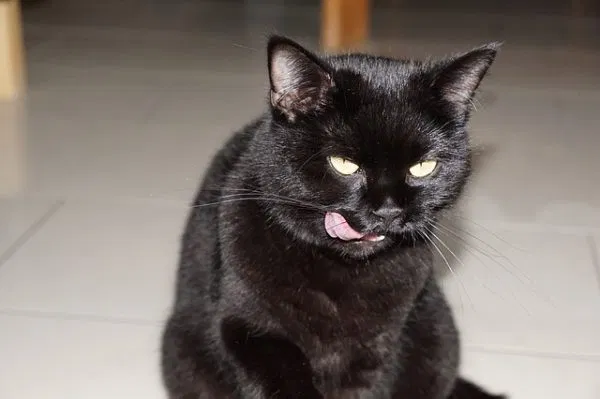
Guest post by Andrea Tasi, VMDMy name is Andrea Tasi, and my whole life revolves around cats and cat care. I graduated from the University of Pennsylvania School of Veterinary Medicine in 1988 and was determined to go out into the world and help sick cats get better, and keep well cats well.
I have been in feline exclusive practice since 1991, first in Philadelphia and now in the Washington DC metropolitan area. I have watched cats become the most popular pet in our country, and been part of the evolution of feline specific veterinary medicine. Where cats were once “second class” citizens in the veterinary community, there is now an explosion of interest in feline medical care and increasing research into feline disease.
How Did I Become interested In Raw Food?
Despite my intentions to try to help cats stay healthy or regain their health, I began to see many cats with chronic problems that I could not “fix”. More and more of my feline patients were on one or more prescription drugs and/or diets to try to help them with the diseases I encountered day-to-day in feline practice: recurrent bladder (lower urinary) problems, obesity, diabetes, chronic vomiting and/or diarrhea, chronic constipation, asthma, skin and ear problems, to name a few. As I prescribed more and more drugs to try to help these cats, I ran into complications and side effects from the drugs themselves, or they often stopped working after awhile. Prescription diets served me no better: often the cats wouldn’t eat them and, even if they did, I did not see uniformly positive results.
One day, a client of mine who had a lovely old cat named Max, told me that she had switched Max’s diet to raw food and all his chronic skin and ear problems went away within several weeks. Poor Max had been on cortisone-type drugs and prescription diets (prescribed by me!) for years, to no avail. My interest was sparked! I began to read about cat nutrition and cat diets and talk to people (veterinarians and pet owners) who had been feeding raw foods. I was amazed at what I was hearing, so decided to try a raw diet with my (then) new kitten, Bug. I had adopted Bug as a sickly (actually near death) and underweight 6-month-old. I watched him blossom on the raw food diet, gaining healthy muscle mass weight but not becoming fat, developing a beautiful coat and clearing many of his chronic health problems without the need of conventional drugs. I am convinced that his raw diet was the foundation for his wonderful recovery.
I watched him blossom on the raw food diet, gaining healthy muscle mass weight but not becoming fat, developing a beautiful coat and clearing many of his chronic health problems without the need of conventional drugs.
I now recommend raw diets to virtually all my clients, and have seen wonderful improvements in my patients’ health. I will never go back to recommending or using processed pet foods.
Why Not Just Use Dry and Canned Cat Foods?
Grain based dry foods are the worst possible thing to feed a cat. Carnivorous predators were designed to eat a meat/whole prey (bones, organs, etc) diet, simple as that! Grain-free dry foods, while perhaps a bit “better” than “regular” dry foods, are extremely high in calories and do not have the water content of a flesh-based diet. Many cats, when on a dry food diet, do not drink enough water to keep their bodies optimally hydrated.
Canned foods are better than dry, but all canned foods are high-heat processed, resulting in breakdown of many natural nutrients. These then need to be replaced with added supplements (all the chemical sounding ingredients on your canned food label tend to be these replaced nutrients). Many, but not all, canned foods also contain grain based ingredients, which can be triggers for a variety of health issues.
Are Raw Diets “Safe?”
There are a couple of ways to examine this question. First, we can ask ourselves if commercial pet food is safe? Numerous pet food recalls have occurred over the past few years and many pets have died from eating commercial pet foods contaminated with melamine and other toxins. Some pet food recalls have involved Salmonella found in dry food. Believing that mass produced foods are uniformly “safe” is a big leap of faith, in my opinion.
Second, we can look at the reality of how a cat’s anatomy and physiology were designed to eat and digest raw meat. Cats have a more acid stomach pH and a shorter gastrointestinal tract, making them less vulnerable to many types of food-borne bacteria. I remind my clients that cats lick their bottoms every day, and do just fine! Third, it is not difficult to create balanced diets that are safe from a nutritional perspective. Using a variety of recipes and meat sources is the best way to ensure that your cat gets all the nutrition she needs.
Isn’t It Very Complicated to Feed Raw Food?
Feeding raw food can be simple! The easiest way to begin is to use commercial frozen raw food diets. Making homemade food is not difficult either. The easiest way to begin is to use a powdered premix such as Instincts-TC™ that turns meat and liver in to a complete and balanced diet. One can then “graduate” to using recipes that require adding several supplement items like taurine, fatty acids, etc.
The most common problems my clients have is that they try to transition too fast, and that they forget to defrost food in advance so it is ready for feeding.
Why Do So Many Veterinarians Caution Against Raw Diets?
Veterinarians actually receive very little training in nutrition. In my four years of veterinary school, I had one class, one semester long, on nutrition. Most of this course focused on which prescription diet to recommend for which disease and why. For well pets, I was taught to recommend “pick one dry food and stick with it.” A major pet food manufacturer supplied free pet food to veterinary students, and free prescription diets to the university’s veterinary hospital for use with hospitalized animals. Is it any wonder that most vets come out of school recommending that manufacturer’s products? We were cautioned that it was “complicated” and “risky” for owners to make their own pet food, and that raw meat was full of harmful bacteria and parasites and would sicken animals, and possibly their owners. As I began to become interested in raw foods and spoke with veterinarians who had been recommending them for years, I was happily surprised to find that raw-food related health problems were few and far between, but that the benefits were amazing!
What Cat Diseases May Be Helped With Raw Food Diets?
I have seen diabetes, asthma, lower urinary tract (bladder) problems, chronic vomiting and/or diarrhea (inflammatory bowel disease-type symptoms), skin and ear problems and other health issues either markedly improve or completely resolve when raw diets were introduced. Every cat will respond in their own way, but I now view real, fresh, raw food as the “best medicine” for many of my patients.
What Do I Feed My Own Cats?
I use a combination of homemade and commercial frozen raw diets. When making homemade food, I use several different recipes and vary my meat sources. My youngest cats like pretty much anything I make, as they were raised on raw. Their favorite meat source is rabbit. My oldest cats love homemade food made with Instincts-TC powdered premix. This “all in one” powder, when mixed with meat and liver, makes a complete diet.
Who Should Not Use Raw Diets?
I recommend avoiding raw meat based diets for cats that are on immunosuppressive medications like chemotherapy drugs, or higher doses of cortisone-type drugs like prednisolone. I also recommend that if anyone in the cat’s household has a weakened immune system (HIV/AIDS, chemotherapy, immunosuppressive drugs, etc.,) extra caution should be used or raw diets completely avoided. In these instances a commercial or homemade cooked diet would be an excellent substitute.
This article was first published here in February 2011, and has been updated. It originally appeared on the Feline Nutrition Foundation website, and is re-posted with permission. The Feline Nutrition Foundation is dedicated to providing thoroughly researched information on feline health and nutrition. If you care about cats and their health, please consider joining the foundation. Membership is free, and a growing membership base will help the organization spread the word about species-appropriate nutrition for cats.
Is it safe to feed my dog raw bones?
Bones contain a variety of minerals that can aid in skin and coat health, and the marrow and cartilage are good sources of collagen. Bones with connective tissues attached are especially beneficial for skin and coat health. Raw meaty bones can be fed to dogs eating any format of food, but can specifically complement a raw diet perfectly.
Use recreational bones to make a healthy bone broth (and if that's to much hassle just get some from us) for your dog. Be sure to choose bones that contain marrow and connective tissues, as this will provide the most nutrition.
Raw Bone Safety
We’ve gone over all the good things about feeding raw bones, but let’s talk about the safety precautions and potential risks of feeding raw bones. I’d love to tell you that all dogs will do perfectly fine eating raw bones, but that is not the case.
Some bones are safer than others, and some bones should never be fed at all. As mentioned before, puppies, seniors, and dogs with compromised dental health may not be suited for raw bones or other hard chews.
Three types of bones are available for dogs: Edible bones, recreational bones, and cooked or smoked bones.
Edible Bones
Let’s start with edible bones. An edible bone is a bone that is softer, usually hollow, and covered in cartilage or other connective or meaty tissues. Typically when we talk about edible bone, we are referring to poultry bones. There are some non-poultry bones that I would consider edible, but they are harder to find and way more expensive to source.
Keep in mind that not all poultry bones are safe to feed, even raw. These include weight-bearing bones. Weight-bearing bones are more likely to splinter. Splintered bone fragments can be very sharp and have the potential to cause damage to your dog’s esophagus, stomach, and intestines.
Here are some poultry bones that are safe for your dog to consume completely:

- Wingtips
- Feet
- Necks
- Backs
These bones are very soft. While they still have a crunch, provide dental benefits, and are high in calcium, they will not be a long-lasting chew for most dogs. Necks and backs are much meatier than wings and feet so they will be higher in calories and fat. Keep that in mind when feeding poultry necks or backs
Always choose a size that is appropriate for your dog. Chicken will be the smallest of the poultry bones, so they are well suited to small to medium-sized dogs. They can even be fed to cats. For larger breeds, look for turkey necks. They are much larger and will discourage your dog from swallowing them whole.
If you are watching your dog's weight or counting calories, then make sure you reduce regular feedings to accommodate for the increased calories in the edible bones that you offer. Edible bones can be part of their daily diet, but you will want to avoid giving them too much calcium.
For raw feeders, feeding edible bones with meals is a common and safe way to provide appropriate amounts of calcium in their diet, but if you already feed a diet complete with calcium, then limit edible bones to smaller portions and only as occasional treats.
If you are looking for larger edible bones for bigger breeds, then try a non-poultry bone. Safe non-poultry alternatives include:

- Lamb, pork, venison, and beef ribs
- Pork feet
- Ox and pork tail
Poultry bones have a higher calcium content than other bones, so if you are using edible bones to supply your dog’s total calcium needs, then try to incorporate some poultry bones into their diet.
If poultry is an allergy trigger for your dog, opt for lamb or pork ribs instead. They provide the closest amount of calcium to poultry.
Recreational bones
A recreational bone is meant for chewing but not necessarily eating. These bones are much harder and should always be fed with caution and under supervision. They do have nutritional value, but because they are not meant to be consumed, they will not replace the need for edible bone in their diet.
The purpose of offering recreational bones is dental health, jaw exercise, and mental stimulation. It’s a nice treat, but is not technically a part of their diet. Dogs can eat these bones, but there are risks.
Don’t offer recreational chews to “gulpers.” They could end up choking or have an intestinal blockage. Both of these are life-threatening, so only feed bones that you know they’re properly chewing.
Some bones are harder than others, and this can affect the safety of the bone. A femur or marrow bone, for example, will be very hard. The risk of your dog chipping or breaking a tooth is much higher than it would be with a softer bone.
Certain animals have very dense bones, which can also increase the dental risk. Beef, bison, and other large bovine bones are among the harder, denser bones. While the risk is higher, this doesn’t mean that all bovine bones are off-limits.
Many dog owners still feed these types of bones to their larger breed dogs as a means of distraction and activity. It’s important to know the risk, but you know your dog best. How they chew and their current dental health are significant factors.
A healthy adult dog with appropriate chewing habits will likely do fine with the occasional recreational bone, but if you are concerned, then stick to edible bone only.
Red meat bones, usually bovine, will make up the majority of the recreational bones. Look for beef bones. The sizes vary depending on the animal, so choose a protein source that is suited to your dog’s size and chewing habits.
Some smaller animals like goats, llama, lamb, and pigs also have larger bones that can be fed, but these bones tend to be trickier to find. Talk to your local butcher to find out what kind of bones they can source.
Here are some of the best recreational bones that you can feed:
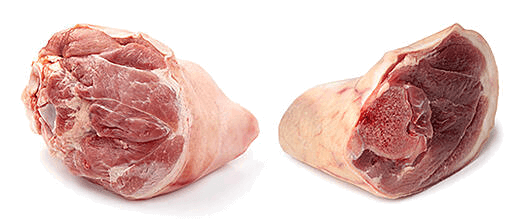
- Knuckles
- Hock bones
- Kneecaps
- Necks
To use recreational bones as a chew, which is the intended purpose, allow your dog to gnaw but not eat. Once the bone has been picked clean of all bits and yummy flavouring, then take the bone away and discard it.
Power chewers will eat just about everything, so be very cautious when feeding these types of bones. Your dog’s stomach acids can break down bone, but only in moderation. If your dog has a habit of swallowing large chunks of bone, then recreational bones are probably not the right choice.
You may want to consider a different type of natural chew that can be broken down easier to prevent choking or digestive issues. Cow ears, tendons, and bully sticks may be better for aggressive chewers, and dogs that are not suited to recreational bones.
Cooked bones
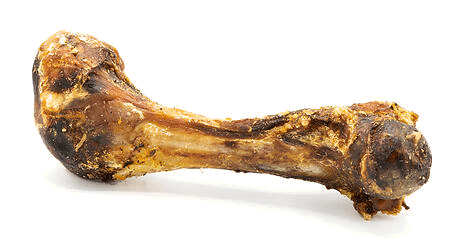
The last form of bone available is a cooked or smoked bone. I highly recommend avoiding this type of bone unless you are very sure that your dog is not consuming them and that they are chewing properly. There are a number of risks associated with cooked or smoked bones.
Brittle Bones that are cooked or smoked get brittle. The chances of splintering or breaking off into sharp pieces is higher in cooked bone. Pets consuming cooked or smoked bones can lead to sickness, vet visits, and sometimes death.
Pieces and shards of bone can do significant damage to their mouth, and there is a scarier risk of the bone fragments damaging delicate tissues along their digestive tract. Cuts or lacerations to the intestines, stomach, or esophagus are painful and life-threatening.
Broken Teeth
Cooked bones are more likely to damage teeth as well. Even an adult dog with healthy teeth can be at risk of cracking or breaking a tooth on a hard, cooked bone. While many dogs have been eating cooked bones for years without incident, tooth damage is still a constant risk.
Not Edible
There are very few cooked bones that I recommend for chewing, and none that I recommend as edible. Anyone that prefers cooked bones is probably concerned about the messiness of feeding raw bones, but trust me when I say that the mess beats risking your pet’s health and safety.
The only cooked bones that I have ever recommended for recreational chewing are knuckles and kneecaps. These bones are covered in connective tissues, like cartilage. These tasty little bits on the bone will keep your dog engaged and mentally stimulated.
The bone is also round, making it much more difficult to break off large pieces. A flatter or longer bone will crack and break into sharp pieces, while a round cartilaginous bone is much less likely to do that.
All that being said, I still recommend monitoring your dog and taking the bone away once your dog has cleaned it off. The risk of splintering or tooth damage is not gone, just reduced.
Tips for Feeding Raw Bones
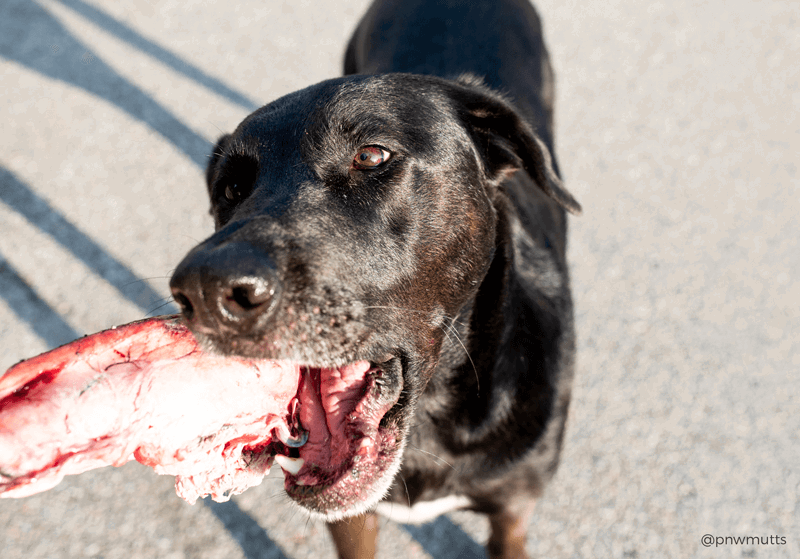 Feeding raw bones can seem a little gross, especially if your dog likes to carry his chews around the house or chew them on the furniture or carpet. A raw bone moving around your home can pose a health risk to you and your family, as the bones will contain the same bacteria as raw meat. To prevent your dog from spreading these germs around the house, here are some best practices to keep you and your pet safe:
Feeding raw bones can seem a little gross, especially if your dog likes to carry his chews around the house or chew them on the furniture or carpet. A raw bone moving around your home can pose a health risk to you and your family, as the bones will contain the same bacteria as raw meat. To prevent your dog from spreading these germs around the house, here are some best practices to keep you and your pet safe:- Choose the right spot to feed. Giving your dog a bone doesn’t mean that they need free reign to move about the house with it. Choose a designated spot for your dog to chew, and make sure that it’s an easy place to clean after they’re done chomping down on their treat. Feed in their kennel, on a washable mat, tile or linoleum, or outside. This may take some training, but be consistent. When you offer the bone, make sure you offer it in the designated area. Try to use a vocal command like "spot" or "place" to help them connect the location with the fun of chewing on a bone. If they move from that spot, take the bone from them, walk them back to their place, and repeat the first steps. You may need to do this several times to help your dog understand.
- In the summer, feed bones partially frozen. Nothing is more refreshing on a hot summer day than a nice cold treat. Help your dog stay cool by offering them a frozen bone. It will take them longer to chew, and will keep them hydrated.
- Use bones as a training opportunity. I learned this nifty trick from a co-worker years ago. If your dog is not keen on baths, feed the bone in the bathtub. It’s both an easy place to clean, and will help your dog associate the tub or shower with their favourite snack. In time, you can try to pour small amounts of water on their feet and back to help them get used to getting wet in the tub. Don’t feed a bone while bathing your dog though. You neither want them consuming the soapy water, or bathing in raw meat juice. Feed the bone after the bath as a reward for good behaviour.
- Any surface that the bone has touched should be cleaned and sanitized. If you use a blanket or towel, throw it in the wash. Tile floor or kennel? Wipe it down. Vinegar is a natural disinfectant that can be diluted in water and used to clean surfaces. It’s great for cleaning up after your pet because it is non-toxic and safe if your dog licks the surface afterwards. Most importantly, wash your hands after touching the bone. Avoid letting your dog give you kisses after chewing on the bone. They will likely have some blood, meat, or bacteria on their muzzle from chewing on it. Use a dog safe wipe or washcloth with warm water to wipe down their muzzle and paws. A quick wipe down will help prevent any residue from spreading around your house.
- Don’t leave bones out. Edible bones typically have tissues and meat on them. Treat them like raw meat. Whatever your dog doesn’t eat in one sitting should be refrigerated. Proper storage will prevent the meat from spoiling, and limit the number of bacteria that are laying around your home.
For recreational bones, even if the bone has been cleaned off by your dog, the bone should be removed and discarded. Leaving a bone out will not only let the bone dry out, making it more likely to splinter or break, but it is also still hosting bacteria from the raw meat. Discarding the bone will prevent pathogens from spreading.
Source: A GUIDE TO FEEDING RAW BONES FOR DOGS
Food & Nutrition | Treats & Chews | Dog
By, Krystn Janisse
What is the risk of bacteria and parasites when feeding a raw diet? By Chefs4Pets
Always apply safe food handling practices when working with raw pet meat. The process should not be any different than when working with human meat and the same principles applied.
Defrost the meals in the fridge rather than leaving it outside and always wash your hands after handling raw meat. All our products are sourced from reputable suppliers and only human grade produce is used in the production of our meals. We have our products micro tested regularly for harmful pathogens to ensure a low bacteria count.
Similar to human raw meat products, you should not leave the meals in the fridge for longer than 2 days. If you offer a meal and it is refused, place the meal back into an airtight container to avoid attracting ‘fridge smells’ and store in the fridge for the next mealtime.
A dog’s system is well equipped to cope with bacteria, that is why they can eat bones that have been buried for a month and not get sick. Their saliva contains an enzyme called lysozyme, which destroys harmful bacteria. Their short digestive tract is designed to digest food quickly, which prohibits the colonization of bacteria. The extremely acidic environment in the gut also destroys any harmful bacteria.
Defrost the meals in the fridge rather than leaving it outside and always wash your hands after handling raw meat. All our products are sourced from reputable suppliers and only human grade produce is used in the production of our meals. We have our products micro tested regularly for harmful pathogens to ensure a low bacteria count.
Similar to human raw meat products, you should not leave the meals in the fridge for longer than 2 days. If you offer a meal and it is refused, place the meal back into an airtight container to avoid attracting ‘fridge smells’ and store in the fridge for the next mealtime.
A dog’s system is well equipped to cope with bacteria, that is why they can eat bones that have been buried for a month and not get sick. Their saliva contains an enzyme called lysozyme, which destroys harmful bacteria. Their short digestive tract is designed to digest food quickly, which prohibits the colonization of bacteria. The extremely acidic environment in the gut also destroys any harmful bacteria.
Okay, give me a list. What are some of the benefits my pet and I can look forward to? By As Nature Intended.
People who have switched their pets to our raw cat and dog food have found:
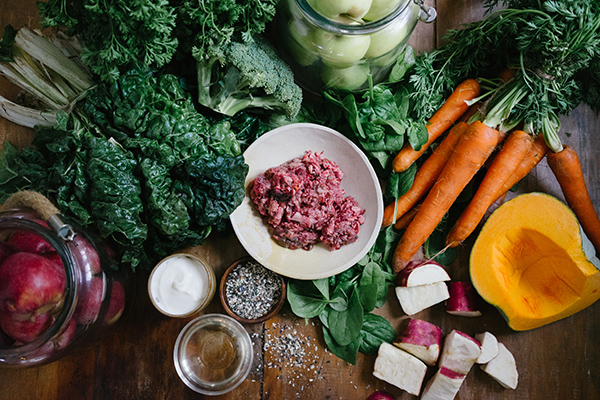
Our customers have shared many other encouraging bits of feedback with us. We could write reams about the benefits but you would be reading all day, so please don’t hesitate to make contact if you have specific questions about health concerns or anything else we haven’t covered here.
- Dry, flaky, itchy, or uncomfortable skin has cleared
- Allergic reactions their pets had previously had on commercial foods have disappeared with the raw diet
- Generally improved mood, energy, and playfulness in both cats and dogs (many owners just thought their pet was naturally lazy or sluggish until they saw the renewed liveliness that a diet change brought about!)
- Teeth are naturally clean – chewing on raw meaty bones helps scrape tartar off the teeth
- Overall improved immune and digestive systems meaning fewer visits to the vet
- Arthritis has significantly reduced in some dogs
- Kidney function has improved in both cats and dogs
- Dogs and cats are excited at meal times – no more of the “do I have to eat this??” facial expression!
- The ripping and chewing involved in eating raw meaty bones develops the jaw, neck, and shoulder muscles, and aids coordination. Commercial foods will never assist in this important muscle development
- Better weight control, for a few reasons:
– the food is more effectively digested (it is not clogged with unnecessarily high levels of carbohydrates)
– pets on commercial food often seem insatiably hungry because their food is not giving them the nutrients their bodies crave – this is no longer the case on the new diet
– owners confess to being less tempted to give table scraps and other excess treats because they watch their pets genuinely enjoy every meal! - No more pet odour
- Stools are smaller and don’t smell as bad – this seems to be one of the most popular changes!
- Cat owners agree, “no more stinky litter boxes and best of all – cat pee smell is non-existent!”
- Their animals are living longer on a raw diet than their previous pets had survived on commercial dog and cat foods
- Despite popular concern, the food is quick and easy to serve
- Bitches manage their pregnancies better
- Better weight and survival rates in puppies and kittens. Young ones develop at a more appropriate rate – and quick growth spurts are avoided. A GOOD breeder will want to stop fast growth in any pup or kitten.
- Decreased vet bills (your dogs and cats are healthier!)
- Pets who were previously on cortisone or anti-biotic medication now need less or none at all
- And the greatest honour of all for us to hear, and we’ve heard it many times, “I think your food saved his/her life”.

Our customers have shared many other encouraging bits of feedback with us. We could write reams about the benefits but you would be reading all day, so please don’t hesitate to make contact if you have specific questions about health concerns or anything else we haven’t covered here.
How do I know if my pet will be happier and healthier on a raw diet? By As Nature Intended

Our first pet whose life was literally saved by the raw diet was our beautiful bullmastiff Kismet. We had watched her suffer for so long, and felt so helpless when vet after vet could do nothing for her. Two allopathic vets told us to put her down, and we felt truly desperate. It is hard to even describe the joy and relief we felt when we found the raw diet that would save her life. Kismet was the first dog to sample our Give a Dog a Bone recipes, and her delight and improved health were our inspiration. There are more details about her and our kitty Flat Cat’s journeys to health on the Our Story page (needless to say, Flat Cat was the founding furry behind Cat of the Day).Our pets were among the many unlucky enough to fall visibly ill, but we have also had so many customers who didn’t even realize their pets weren’t as happy or healthy as they could be until after they had changed them to raw dog and cat food. Chandre tells many of our customers about her cat Cuddles, who, at the age of three, did nothing but sleep. Her previous cats had suffered from bladder and kidney problems, and she says, “It was frustrating for me because I was doing everything ‘right’ according to the ‘rules’ of looking after your cat. But my cats just kept on being sick, which left me with the constant question, ‘what am I doing wrong?’” Chandre decided to try something new, and switched Cuddles to the Cat of the Day raw diet.
Cuddles became like a kitten again – playful, energetic, and simply happier. He showed no signs of the previous cats’ bladder or kidney problems. Cuddles’ vet was so excited when she saw his shiny coat, glowing eyes, and sparkling teeth, and was amazed to hear that all it had taken was a change to a natural raw diet.
Why did you change your pets’ diets, and why should I? By As Nature Intended
We are a family with both two-legged and four-legged family members. We have always been slightly dog-crazy, and when our zany cat Flat Cat came into our lives, we swore it was possible to be equally “dog” and “cat” people. It was only when these beloved furry four-leggeds became sick from eating an expensive brand of pellets that our eyes were opened to raw feeding.
An article by Born Free USA entitled What’s Really in Pet Food put us off pellets for good. It made us realise that we had had no idea what the mysterious dry kibble was really made of. It promised complete health on the label but the listed ingredients in no way resembled real food.
Dr Karen Becker puts it this way, The truth is our pet population provides a place for recycling waste from the human food industry. Grains that fail inspection, human food past its expiration date, uninspected pieces and parts of waste from the seafood industry, leftover restaurant grease, deceased livestock, and even roadkill is collected and disposed of through rendering – a process that converts human food industry waste into raw materials for the pet food industry. Dry Pet food manufacturers purchase these raw materials and blend the rendered fat and meat with starch fillers.
An article by Born Free USA entitled What’s Really in Pet Food put us off pellets for good. It made us realise that we had had no idea what the mysterious dry kibble was really made of. It promised complete health on the label but the listed ingredients in no way resembled real food.
Dr Karen Becker puts it this way, The truth is our pet population provides a place for recycling waste from the human food industry. Grains that fail inspection, human food past its expiration date, uninspected pieces and parts of waste from the seafood industry, leftover restaurant grease, deceased livestock, and even roadkill is collected and disposed of through rendering – a process that converts human food industry waste into raw materials for the pet food industry. Dry Pet food manufacturers purchase these raw materials and blend the rendered fat and meat with starch fillers.
Why Raw? By Doggobone
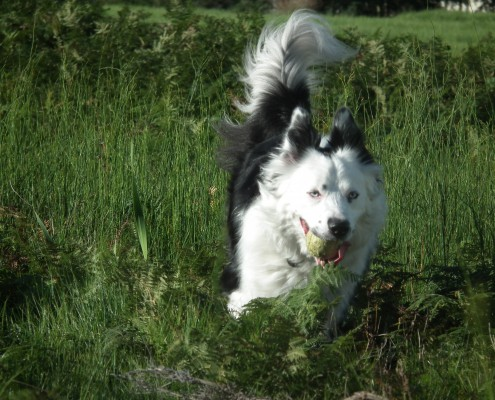
Merlin, owned by Maxell Lerm
Deciding which food to feed your pet, can become a confusing and daunting task with so many different brands on offer. Ultimately our choice of nutrition is an integral segment of this process so that our companions can live a long and healthy life. Having a pet is not a privilege, instead it is a symbiotic relationship of companionship and trust that extends beyond all the boundaries of everyday life. Animals are part and parcel of our ecosystem and like no man is an island so too this world would not be in balance if we only existed without the animal kingdom.
Unfortunately, commercial pet food companies have cleverly decided how we should feed our pets. Through extensive marketing drives, scare-mongering, glossy packaging to mention a few. Creating the idea that the consumer is incapable of providing wholesome meals for their pets without the collaboration from corporate executives. It is highly unlikely we would consume the same processed foods everyday of our lives. Appropriate, sustainable nutrition can be achieved by choosing a diet that varies, is fresh, unadulterated and is brimming with living enzymes that are required to sustain life on a daily basis.
Although we cannot copy the footprint of Mother Nature we can surely mimic what dogs and cats evolved were designed to eat naturally. By providing for them a biologically appropriate meal that allows their systems to work effectively and hopefully building their immune system through a diet that puts very little stress on the body and ultimately helps protect them from degenerative diseases and other health complications associated with poor nutrition. “It is not the germ, it is all about the terrain.” Louis Pasteur.
Be sure to use our handy feeding calculator at the bottom of the page to calculate the amount of Active Raw food to feed your pet. Please note that these calculations are a guideline only and quantities may need to be adjusted to suit the individual.
Some potential benefits pet parents have observed when feeding Doggobone
- Healthy, shiny coat with little or no odour.
- Better breath, reduced tartar build-up and healthy teeth.
- A noticeable Reduction in allergies, skin ailments and ear infections.
- Increased energy.
- Smaller, biodegradable, less odious stools.
- Ideal weight control – Raw food, keeps your pet’s weight in control by feeding the amount of food appropriate to your pet’s needs. The body is not maintained by the amount of food fed but by the amount of nutrients in the food that are absorbed by the body.
Technically, our domesticated dogs and cats may or may not differ from their wild counterparts in many ways as science has tried to prove, but their dentition and digestive system has in essence remained unchanged. By domesticating them and feeding what we have been accustomed to eat in no way means that just because their bodies are able to utilize some of the nutrients from the food being fed that it is the appropriate nutrition for them.
Therefore feeding a species appropriate raw food should be the first choice of nutrition for cats and dogs. It also imperative to remember that feeding pets this way is not re-inventing the wheel but rather returning to how they should have been eating in the first place.
Who is Doggobone? By Doggobone

INTRODUCING DOGGOBONE!
Doggobone produces raw food for companion animals from its facility in Cape Town. Our Food differentiates itself from other companies in the industry with strict adherence to grain and preservative free food. The meals have been developed to cater for your pet’s individual needs. All products are produced at our environmentally controlled facility and flash frozen. One can never replace what “Mother Nature” has to offer, except providing a meal that closely mimics what dogs and cats were designed to eat in the wild.
The desire to feed a healthy appropriate meal for our own pets kick-started this journey of research and development under the watchful eye of a renowned animal nutritionist from New Mexico in the U.S.A.
Doggobone Active Raw Food products are certified and registered under Act 36 of 1947. This is a legal requirement when producing food for animals commercially. We offer a wide variety of ready-made minced meals, whole-foods and treats.
We have a proven track record and can proudly say we are one of the dominant role players in the pet food industry in South Africa producing raw complete meals for companion animals.
Our Products
All raw ingredients (meat, poultry, vegetables, fruit and herbs) are sourced locally, from Department of Health approved establishments within South Africa and certified fit for human consumption. No chemicals, preservatives, flavourings, denatured or rendered products are used to enhance the appearance, taste or texture of the meals. Everything we use is grown and farmed in the Republic of South Africa. We grow some of our own vegetables to reduce the carbon footprint on the environment and to promote sustainability and create more employment.
Note: Tripe used for human consumption has to be scalded or bleached to ensure it is “fit for human consumption” this process denatures most of the nutritional benefit of the tripe. Our method of using Green unbleached tripe therefore, it cannot be regarded and we cannot claim it is fit for human consumption.
The proteins in our minced meals are derived from a number of sources e.g. Beef, Chicken, Lamb, Ostrich, Duck and Game. These are combined with seasonal vegetables, fruit and herbs. On the recommendation of our Nutritionist we have also added an approved vitamin and mineral to close the ‘gap’ in the event any nutrients are lost during the production processes. By combining a wider range of ingredients improves the nutritional benefit and integrity of the product as a complete and balanced meal. Each variant may be fed as a meal on its own, or combined to create a balance for the nutritional benefit of your dog or cat.
Finely Ground Meat
Meat is an important aspect of a raw diet, although it cannot be the only component. Meat is a great source of protein and supplies varying amounts of fats, water, and some vitamins and minerals. Meat supplies with energy to the body.
Bones
The dog’s body is built to consume bones, it is necessary to include Bones in a raw diet. Bones are living tissue. Raw Bones contain a wide variety of nutrients, vitamins, minerals, proteins, natural antioxidants (enzymes and anti-aging factors), and fats (essential fatty acids). The bone marrow alone is a highly nutritious mix of blood forming elements, such as iron. Never give your dog cooked bones; it is not only unhealthy for a dog, but also dangerous.
Organ Meat
Organ meat includes the internal organ meats, which are vital for a healthy dog, although not required in large amounts. Offal is great for dogs during times of growth, reproduction, and stress. It mainly contains all the vitamins, probiotics, iron, zinc, phytonutrients and essential source of enzymes that are an integral part of a dog’s well-being.
Vegetables and Fruit
Dogs need some raw vegetables and fruit in their diet as they contain essential nutrients, vitamins, enzymes, antioxidants, and are a excellent source of fibre as well as vitamin A and vitamin C. Vegetables and Fruit have proven to have anti-aging properties. It is not required in large amounts and is included basically to mimic the stomach content of the prey.
Herbs, Vitamins and Minerals
Our nutritionist has prompted us to add important and natural ingredients to the diets. Although, these ingredients are included in small quantities we support the view that these ingredients are needed to form a more complete and nutritionally based product. Taking into account our environment has been robbed of its many natural minerals and the soil quality is not as it was years ago as well as with the constant damage being done through global warming and industrialization. We feel that the addition of these ingredients have made our products even better.
Who is As Nature Intended. By As Nature Intended
Loving Our Pets: Feeding Them Nature’s Food
We are a family who loves our animals. We have been blessed with wonderful pets who have played a big role in rearing our daughter! Our first experience of raw feeding happened twenty-one years ago with our bullmastiff, Kismet.
For the first two years of her life, Kismet was plagued by health problems. The worst of these was a skin condition which would start as a rash and erupt into raw, open sores. After what felt like endless failed attempts with conventional veterinary treatments (antibiotics, cortisone) we were advised to put our gorgeous girl down and end her suffering. In desperation we searched for a holistic vet.

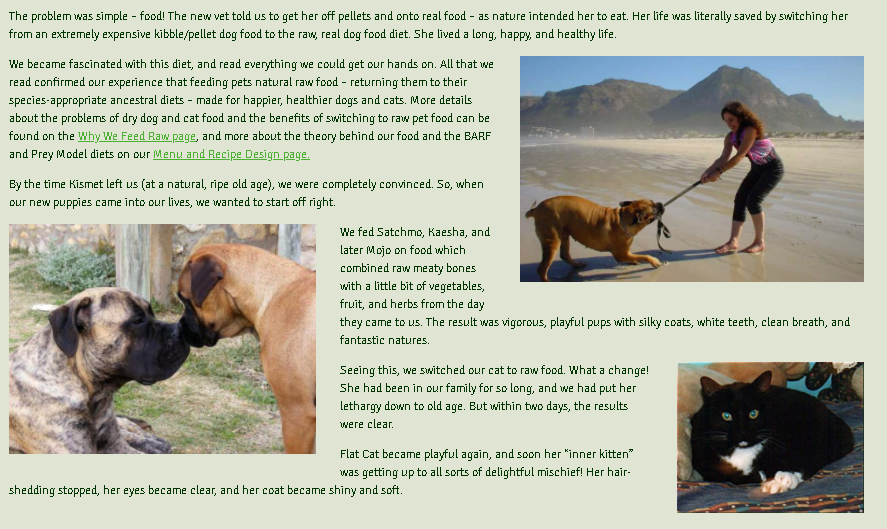
Sharing Our Delight
We were so excited by the changes in our furry family members that we couldn’t stop telling our friends about it. Many of them asked to try our food for their own pets.
One friend had a dog who suffered from constant diarrhoea. After changing to our raw dog food, she told us that her dog had normal stools for the first time in his life. This was after many vet visits and unsuccessful attempts at treatment. Another friend said that she hadn’t even realised that her dog was depressed – she had thought that his combined lethargy and anxiety were simply a part of his nature. With a change to our raw dog food, she watched him transform into a confident, lively dog.
Of course we continued to see the vet who had changed our lives already. One day, he surprised us by saying “Why don’t you sell your food to other people?” We had no idea how much he was about to change our lives again. With the assurance that he and other experts would be on hand to help us with the continual growth and learning it would take to understand cat and dog nutrition fully enough to do it right, we decided to go for it.
That was way back in 2009. Since then, our recipe range has grown, we have analysed, tested, and legally registered all our foods, and the positive reviews from dogs and cats have not stopped rolling in (their humans seem pretty happy too).
We have been so inspired to see the results. The Feedback From Well-Fed Friends page is a joyful celebration of our clients’ pets and their stories. Dogs and cats with itchy skins have found relief on the raw diet. Pets with kidney problems are seeing vast improvements. Bad dog and cat smells have cleared up. Animals are excited at mealtimes, and generally more content. An added perk for the humans is that pets have fewer, less smelly stools! Even more encouraging – customers report fewer vet visits and lower vet bills.
And The Family Grew…

Behind the Scenes (where the magic happens)
Chris, Fanny, Chicco, Bob, Mungoni, and Innocent


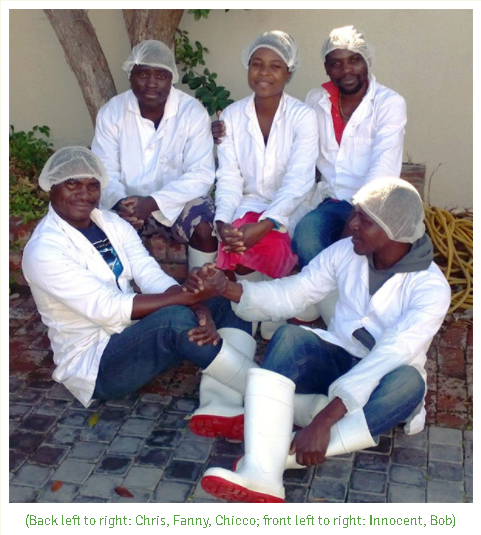

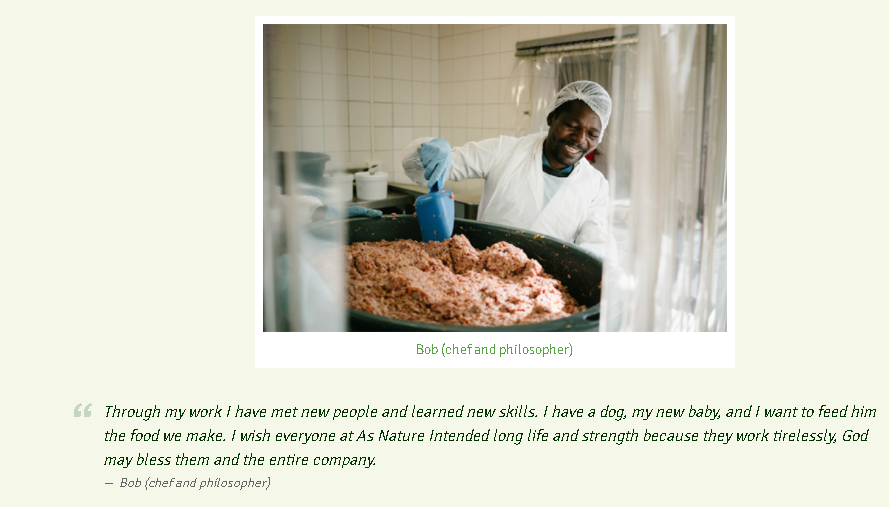
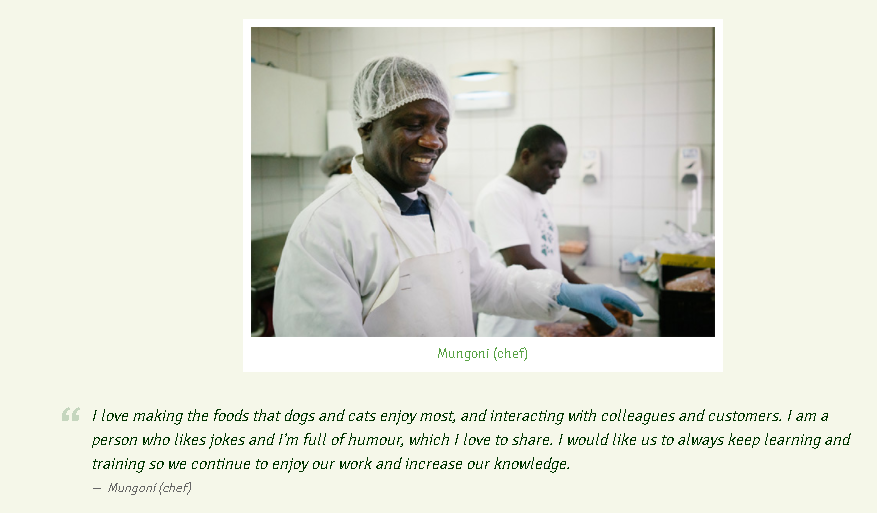
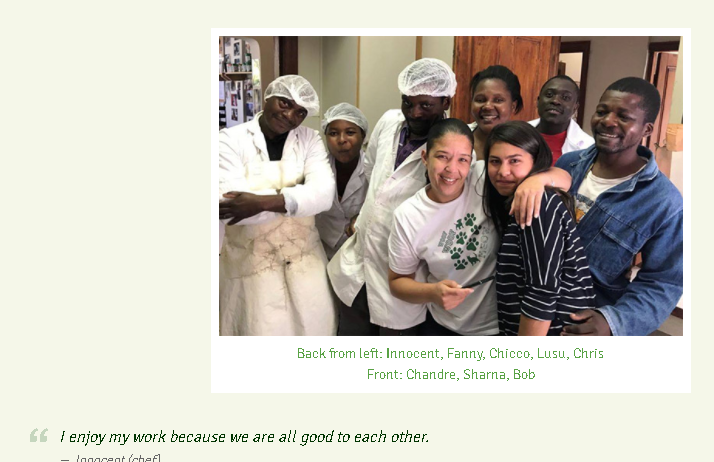
Front of House (where the magic comes to you)
Chandre, Aubrey , Sharna, Cathy, Cheryl and Chris
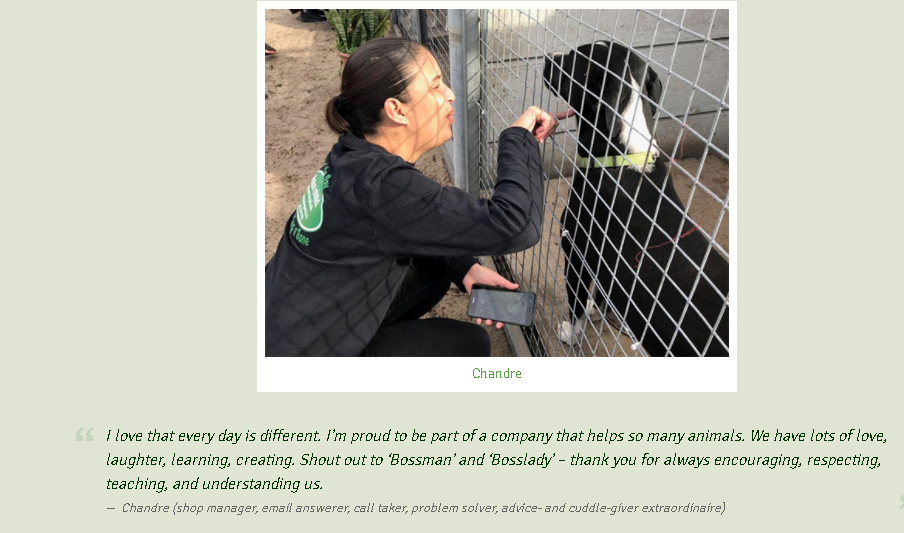

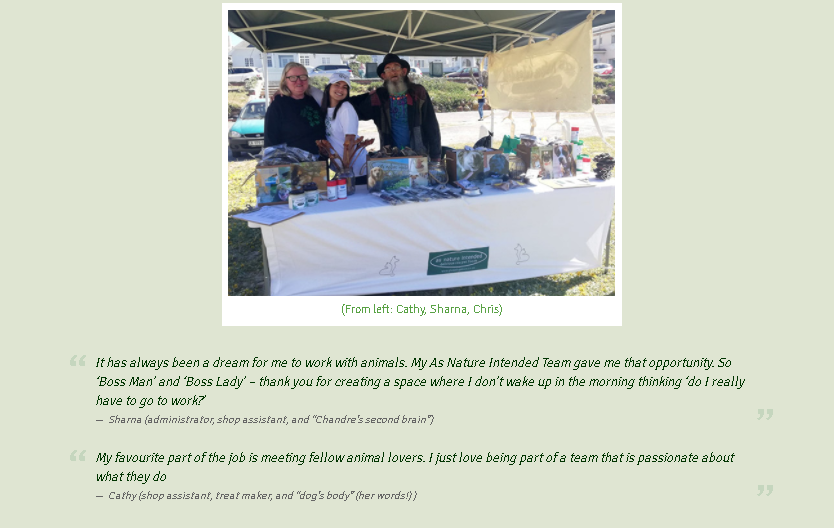
We are a family who loves our animals. We have been blessed with wonderful pets who have played a big role in rearing our daughter! Our first experience of raw feeding happened twenty-one years ago with our bullmastiff, Kismet.
For the first two years of her life, Kismet was plagued by health problems. The worst of these was a skin condition which would start as a rash and erupt into raw, open sores. After what felt like endless failed attempts with conventional veterinary treatments (antibiotics, cortisone) we were advised to put our gorgeous girl down and end her suffering. In desperation we searched for a holistic vet.


Sharing Our Delight
We were so excited by the changes in our furry family members that we couldn’t stop telling our friends about it. Many of them asked to try our food for their own pets.
One friend had a dog who suffered from constant diarrhoea. After changing to our raw dog food, she told us that her dog had normal stools for the first time in his life. This was after many vet visits and unsuccessful attempts at treatment. Another friend said that she hadn’t even realised that her dog was depressed – she had thought that his combined lethargy and anxiety were simply a part of his nature. With a change to our raw dog food, she watched him transform into a confident, lively dog.
Of course we continued to see the vet who had changed our lives already. One day, he surprised us by saying “Why don’t you sell your food to other people?” We had no idea how much he was about to change our lives again. With the assurance that he and other experts would be on hand to help us with the continual growth and learning it would take to understand cat and dog nutrition fully enough to do it right, we decided to go for it.
That was way back in 2009. Since then, our recipe range has grown, we have analysed, tested, and legally registered all our foods, and the positive reviews from dogs and cats have not stopped rolling in (their humans seem pretty happy too).
We have been so inspired to see the results. The Feedback From Well-Fed Friends page is a joyful celebration of our clients’ pets and their stories. Dogs and cats with itchy skins have found relief on the raw diet. Pets with kidney problems are seeing vast improvements. Bad dog and cat smells have cleared up. Animals are excited at mealtimes, and generally more content. An added perk for the humans is that pets have fewer, less smelly stools! Even more encouraging – customers report fewer vet visits and lower vet bills.
And The Family Grew…

Behind the Scenes (where the magic happens)
Chris, Fanny, Chicco, Bob, Mungoni, and Innocent







Front of House (where the magic comes to you)
Chandre, Aubrey , Sharna, Cathy, Cheryl and Chris





